Sao Tome & Principe, located off the west coast of Africa, is home to a rich and diverse population of birds. From the striking seabirds of its offshore islands to the colorful endemic species of the mainland, it is a paradise for bird enthusiasts.
From the tiny sunbirds to the majestic frigatebirds, Sao Tome & Principe offers a unique opportunity to observe various avian life. This article will explore the various bird species in the region, their habitat, conservation status, and behaviors.
1. São Tomé Fiscal
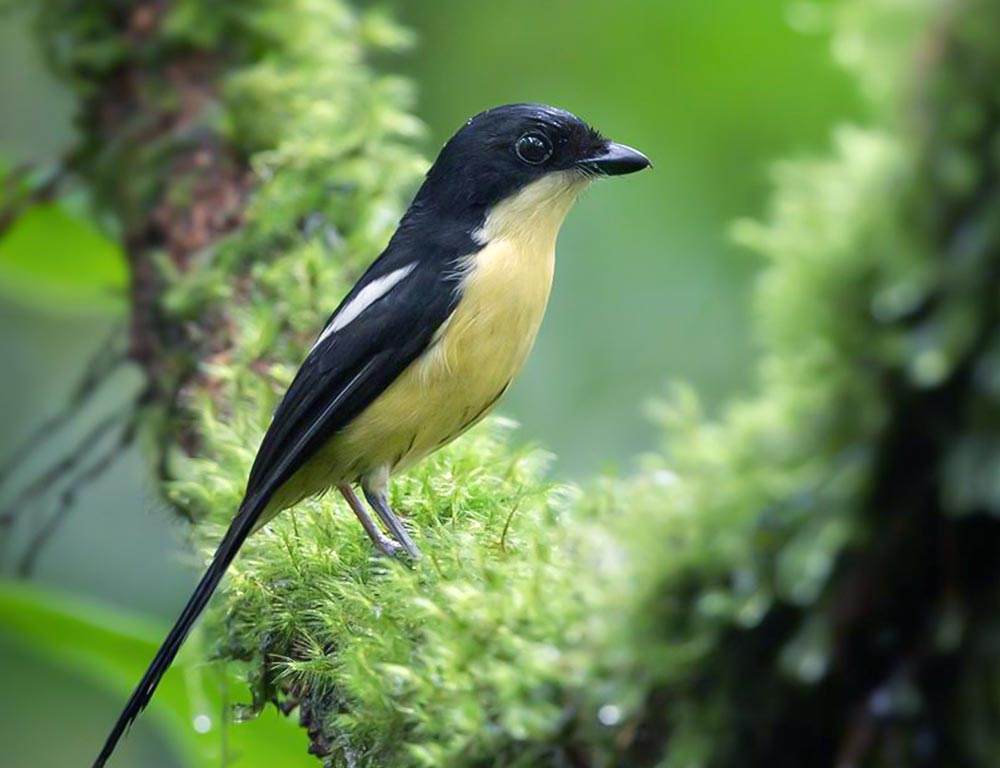
The São Tomé fiscal is a medium-sized bird endemic to the island of São Tomé in the African nation of São Tomé and Príncipe.
It measures between 20 and 21 cm long, with black upperparts accented by a white shoulder scapular bar.
The underparts have varying shades of yellow, while its tail feathers are all black apart from those at the tip, which graduate outwardly.
This nocturnal species inhabits primary forests where it feeds on insects, spiders, and other small invertebrates found among foliage or on tree trunks.
Its population numbers remain unknown due to lack of survey data, but habitat loss poses an immediate threat to this highly localized species’ survival.
Scientific classification:
| Kingdom | Animalia |
| Phylum | Chordata |
| Class | Aves |
| Order | Passeriformes |
| Family | Laniidae |
| Genus | Lanius |
| Species | L. newtoni |
2. São Tomé Prinia
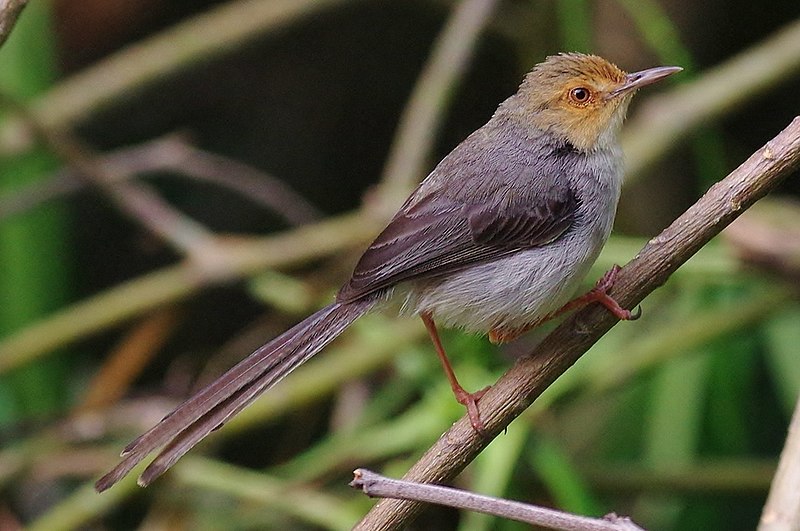
The São Tomé prinia is a species of bird found only in the island of São Tomé and Príncipe. It belongs to the family Cisticolidae, which José Vicente Barbosa du Bocage named in 1887.
This small passerine inhabits both subtropical moist montane forests and shrublands. Its plumage has an olive-brown upper body with dull yellowish underparts, making it quite inconspicuous among its surroundings.
The endangered species face threats from habitat destruction due to commercial plantations and unsustainable harvesting of wood for charcoal production on the islands, thus requiring active conservation efforts if its population is to remain stable or increase in numbers.
Scientific classification:
| Kingdom | Animalia |
| Phylum | Chordata |
| Class | Aves |
| Order | Passeriformes |
| Family | Cisticolidae |
| Genus | Prinia |
| Species | P. molleri |
3. São Tomé Olive Pigeon
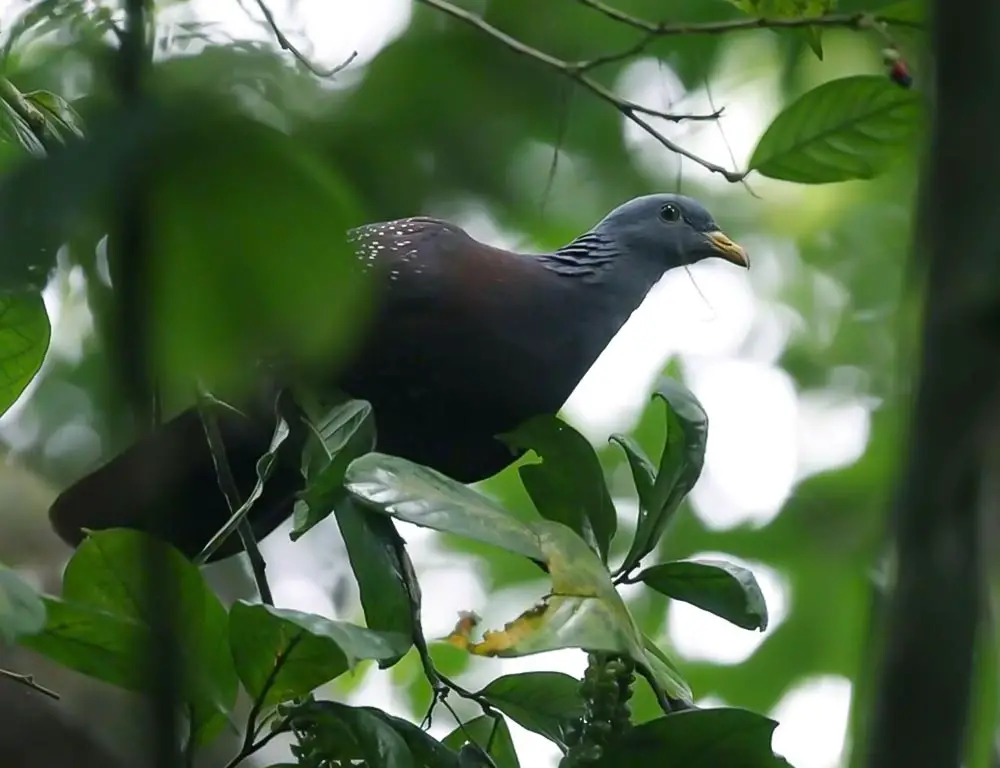
The São Tomé olive pigeon, also known as the maroon pigeon, is an endangered species native to the Island of São Tomé off the western coast of Africa.
It was first described by José Vicente Barbosa du Bocage in 1888 and measures 37-40 cm (15-16 inches) long.
The bird can be found across different parts of São Tome, such as Chamiço in the northwest or coastal forests near Santana or Bombaim on Príncipe Island.
Its wings are a distinctive brownish-grey color with a whitish underside with black spots around its neck region.
Due to human activities like deforestation and hunting for food, this species has become critically endangered, leading to conservation efforts by various organizations trying to protect it from extinction.
Scientific classification:
| Kingdom | Animalia |
| Phylum | Chordata |
| Class | Aves |
| Order | Columbiformes |
| Family | Columbidae |
| Genus | Columba |
| Species | C. thomensis |
4. Giant Sunbird
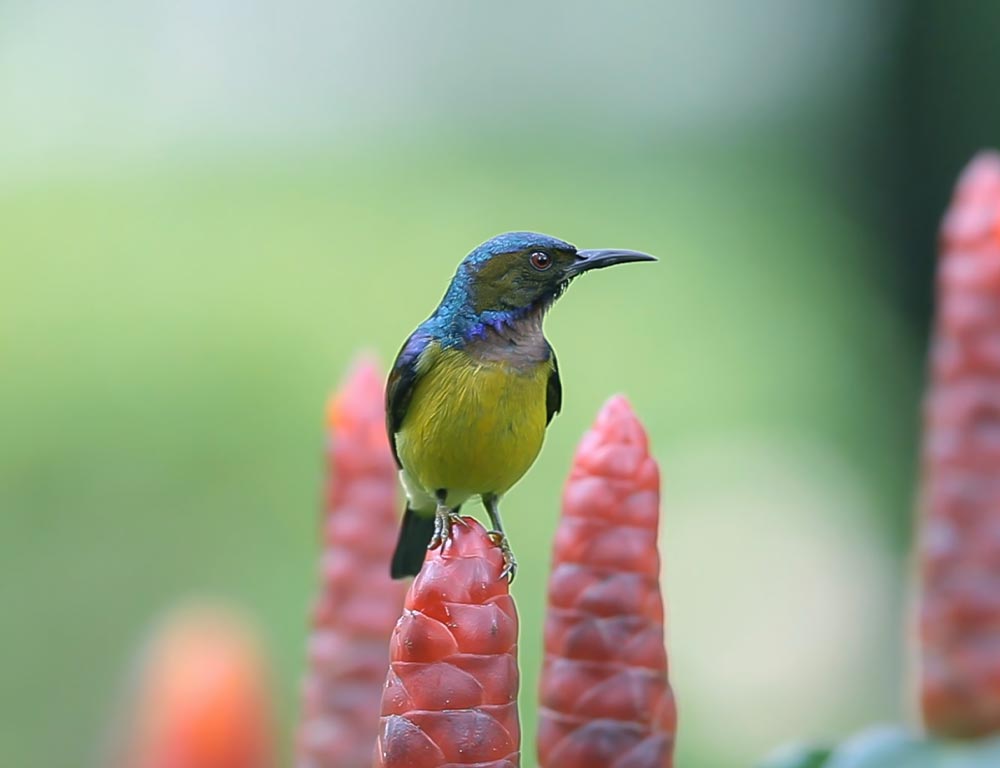
The Giant Sunbird is a remarkable species of bird found only on the island of São Tomé in Central Africa.
It belongs to the Nectariniidae family and is unique amongst its kind, being the only member of its genus Dreptes.
This beautiful creature can be seen flitting through subtropical lowland or montane forests, feeding mainly on nectar from flowers using its long curved bill.
Unfortunately, deforestation threatens their natural habitats, and they are now considered vulnerable by conservationists.
The vibrant colors of this majestic sunbird will live forever as an emblem for preserving biodiversity in tropical regions worldwide.
Scientific classification:
| Kingdom | Animalia |
| Phylum | Chordata |
| Class | Aves |
| Order | Passeriformes |
| Family | Nectariniidae |
| Genus | Dreptes Illiger, 1811 |
| Species | D. thomensis |
5. Giant Weaver
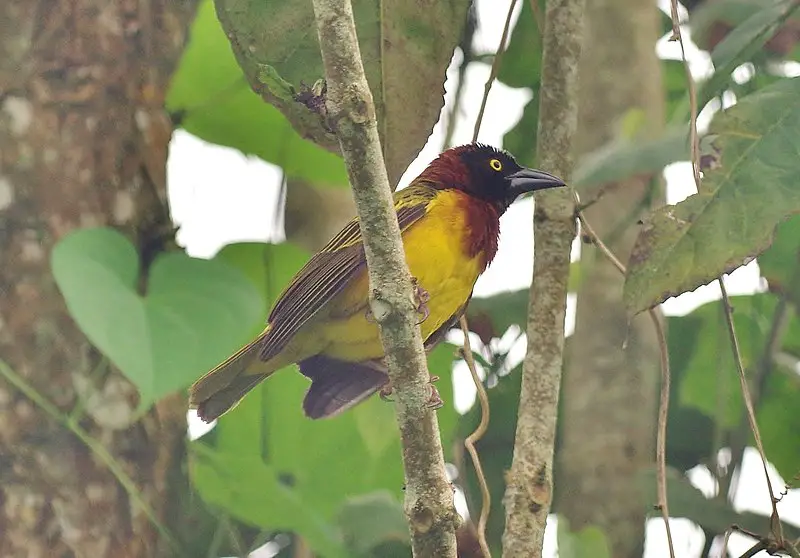
The Giant Weaver is an endemic bird found on the island of São Tomé. Its ability to climb trees and branches resembles a treecreeper or sittella.
The bird inhabits subtropical lowland forests, feeding mainly on insects and fruits.
Its plumage is quite striking; males have black wings with white patches, whereas females are brownish-grey in color.
In addition, both sexes possess bright yellow eyes, which help them spot potential prey from afar.
Due to loss of habitat due to deforestation and overhunting by local people, this species faces many threats that could lead to their extinction if not addressed soon enough.
Scientific classification:
| Kingdom | Animalia |
| Phylum | Chordata |
| Class | Aves |
| Order | Passeriformes |
| Family | Ploceidae |
| Genus | Ploceus |
| Species | P. grandis |
6. São Tomé Thrush
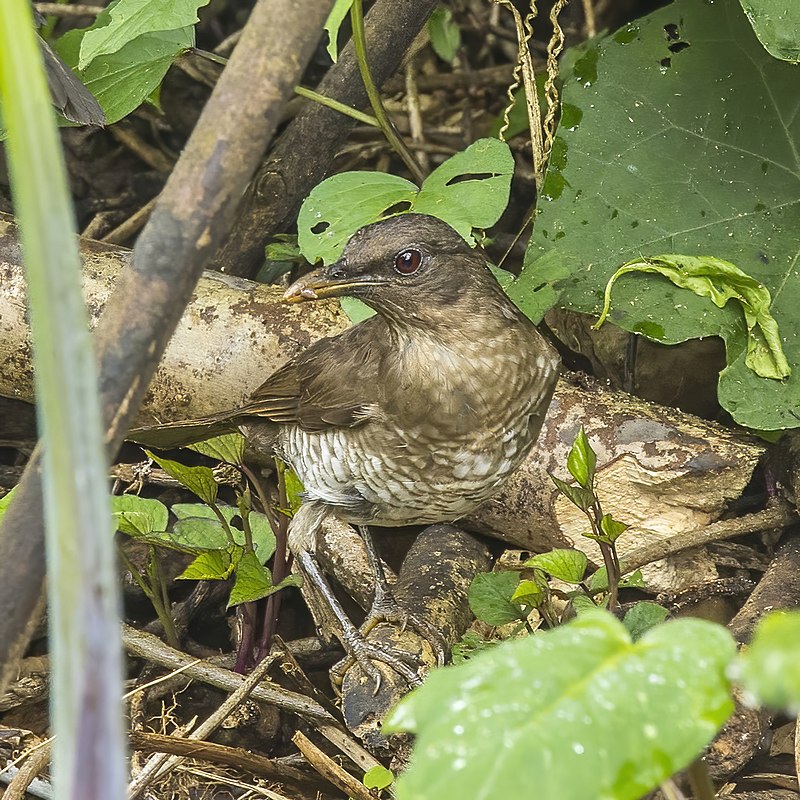
The Sao Tome Thrush is a bird species endemic to the island of Sao Tome. It can be found in both subtropical lowland and montane forests, making it well-suited for its environment.
Its plumage has primarily an olivaceous coloration with some darker markings on top, which helps it blend into its surroundings.
The Príncipe Thrush was once considered a subspecies but now stands as its own distinct species due to slight differences in their morphology and behavior.
This thrush plays an important role in maintaining healthy ecosystems by helping disperse tree seeds through consumption or defecation after feasting on fruits from these trees.
Scientific classification:
| Kingdom | Animalia |
| Phylum | Chordata |
| Class | Aves |
| Order | Passeriformes |
| Family | Turdidae |
| Genus | Turdus |
| Species | T. olivaceofuscus |
7. Príncipe Seedeater
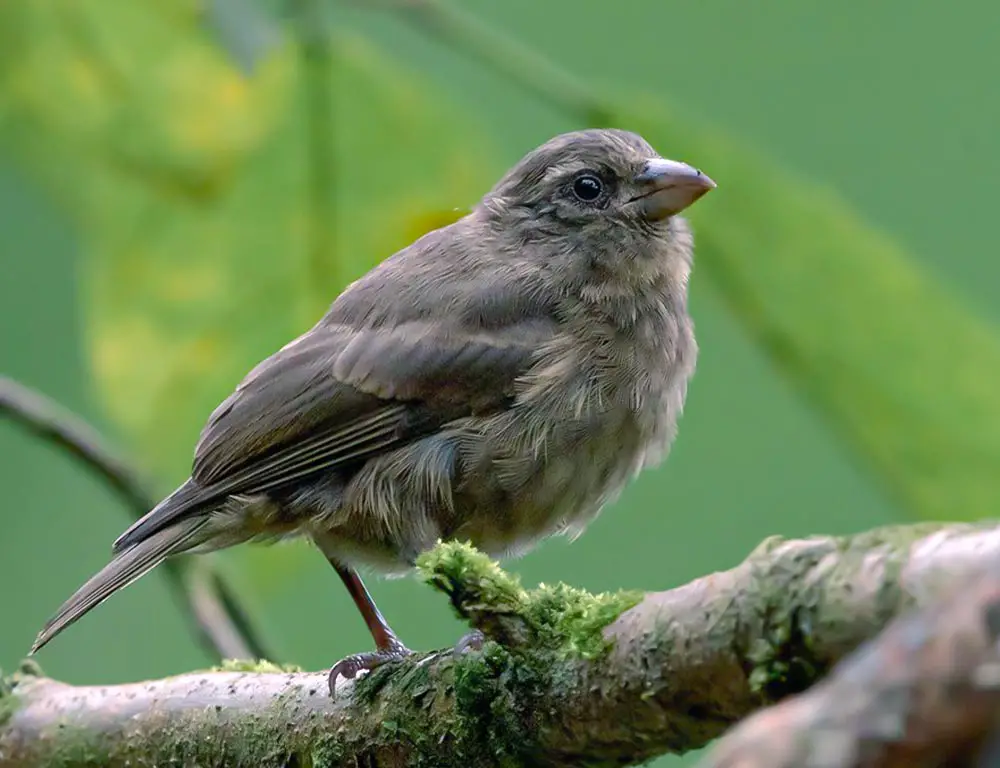
The Príncipe seedeater is an attractive species of finch found only on the islands of São Tomé and Príncipe, off the west coast of Africa.
This lovely bird inhabits both dry and moist lowland forests, preying mainly on seeds.
Its plumage is distinctively pale yellowish-brown to greyish with a dark brown crown and light barring along its wingspan.
It also has a short curved bill that helps it crack open hard shells for food sources such as nuts or insects.
Due to its limited range within these two African Islands, this species faces many threats from habitat destruction due to logging activities in their native forests and predation by cats and rats introduced by humans into these areas.
Conservation efforts are needed now more than ever if we want to preserve this unique bird for future generations.
Scientific classification:
| Kingdom | Animalia |
| Phylum | Chordata |
| Class | Aves |
| Order | Passeriformes |
| Family | Fringillidae |
| Subfamily | Carduelinae |
| Genus | Crithagra |
| Species | C. rufobrunnea |
8. Príncipe Weaver
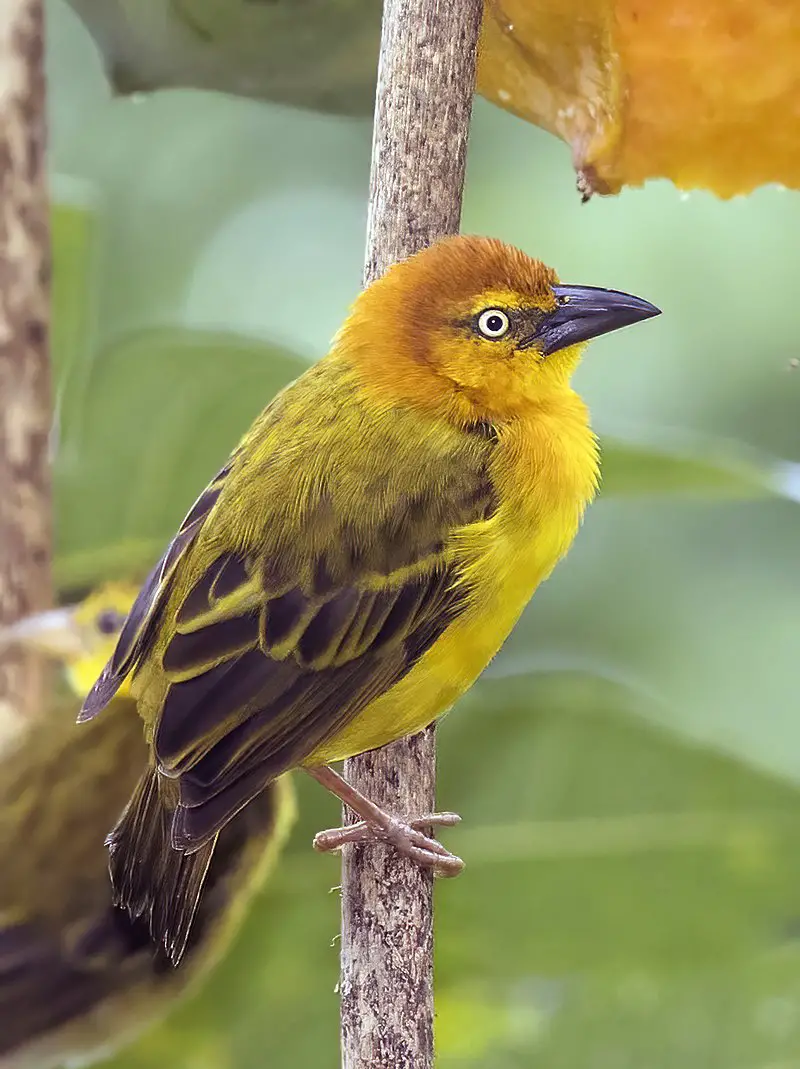
The Príncipe weaver is a species of bird in the family Ploceidae that is endemic to São Tomé and Príncipe.
It was first described by Charles Lucien Bonaparte in 1851, who noted its unique features such as yellowish-green plumage and white eye line.
This species resides mainly on the island of Principe, inhabiting subtropical or tropical moist lowland forests where it nests among tree branches typically close to water bodies such as rivers and streams.
The male birds are known for their elaborate courtship display, which involves fast circling with wide open tails while calling out loudly.
These friendly birds form large flocks outside breeding season when they travel from place to place, searching for food together.
Scientific classification:
| Kingdom | Animalia |
| Phylum | Chordata |
| Class | Aves |
| Order | Passeriformes |
| Family | Ploceidae |
| Genus | Ploceus |
| Species | P. princeps |
9. São Tomé Paradise Flycatcher
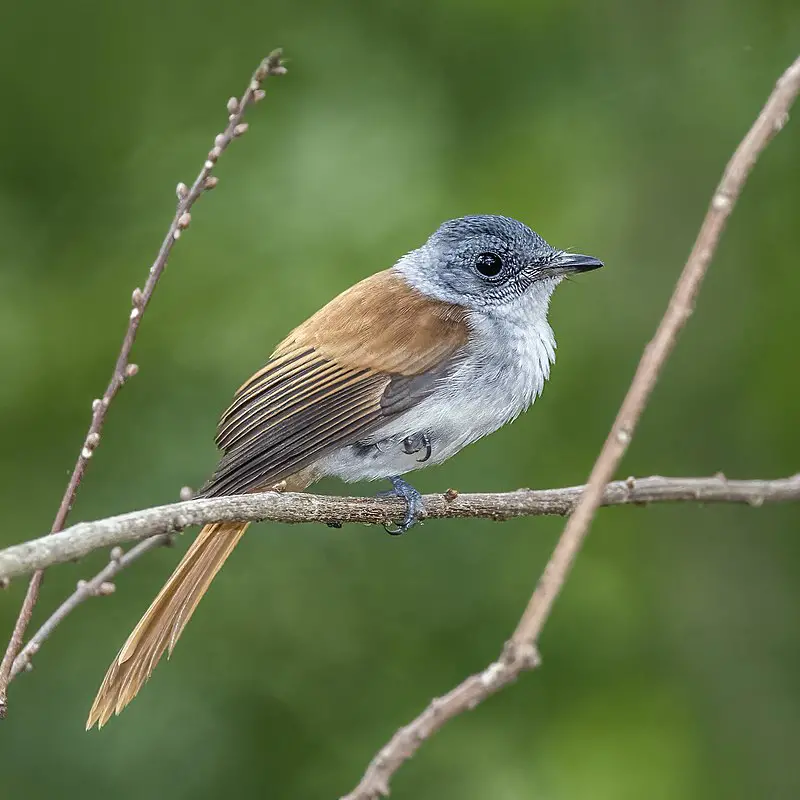
The São Tomé paradise flycatcher is a beautiful species of bird endemic to the island of São Tomé.
It belongs to the family Monarchidae and was first described by Thomas Richard Heywood Thomson in 1842 from Fernando Po as its type locality.
These birds are usually found in subtropical or tropical dry forests, mangrove forests, woodland, and savanna habitats where they forage for insects among branches and leaves.
They have distinct black plumage with white patches on their wings along with bright yellow beaks, which make them easily recognizable amongst other birds.
The breeding season begins during March-April after which both male and female take turns incubating eggs before finally fledging off young ones in July-August period making this one of the most talented families around.
Scientific classification:
| Kingdom | Animalia |
| Phylum | Chordata |
| Class | Aves |
| Order | Passeriformes |
| Family | Monarchidae |
| Genus | Terpsiphone |
| Species | T. atrochalybeia |
10. São Tomé Weaver
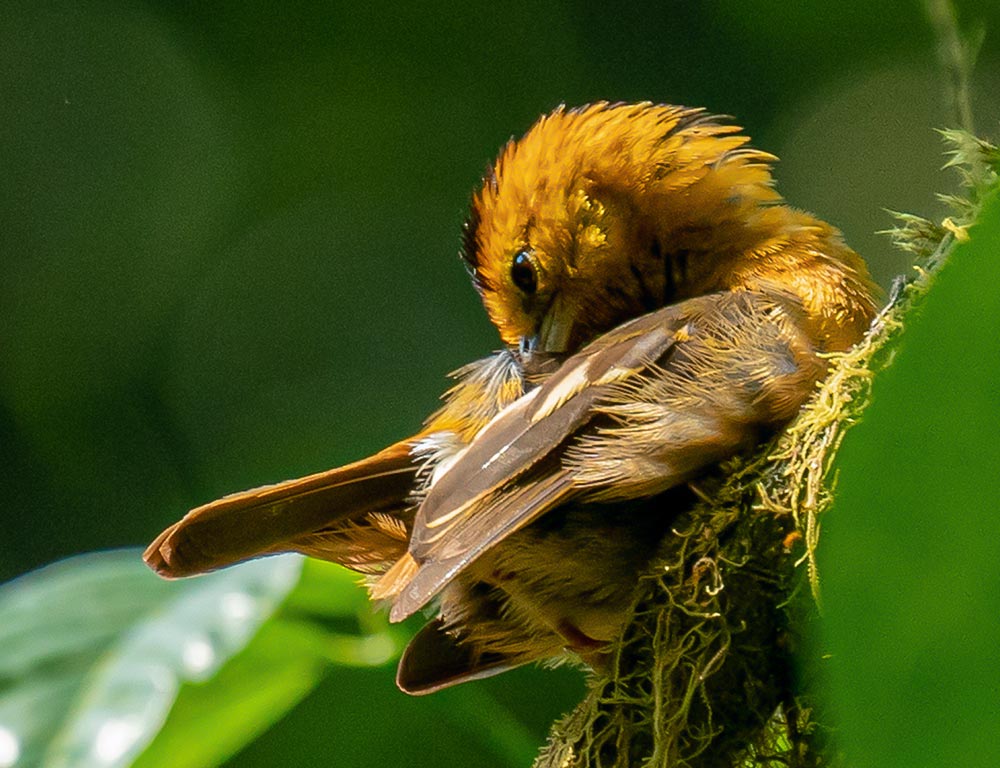
The São Tomé weaver is a species of bird belonging to the family Ploceidae and endemic only to the islands of São Tomé and Príncipe.
These birds are found primarily in lowland tropical forests and some montane regions. They tend to form large flocks when foraging or looking for food but can also be seen alone at times.
The males often have bright colors like yellow-green above with black on their wings and head, while females typically appear duller than the males in coloration.
Despite being found mostly around moist areas near rivers or streams, they need not rely heavily on water sources because they can get the most hydration from fruits they regularly consume during feeding bouts daily.
Scientific classification:
| Kingdom | Animalia |
| Phylum | Chordata |
| Class | Aves |
| Order | Passeriformes |
| Family | Ploceidae |
| Genus | Ploceus |
| Species | P. sanctithomae |
11. Principe Starling
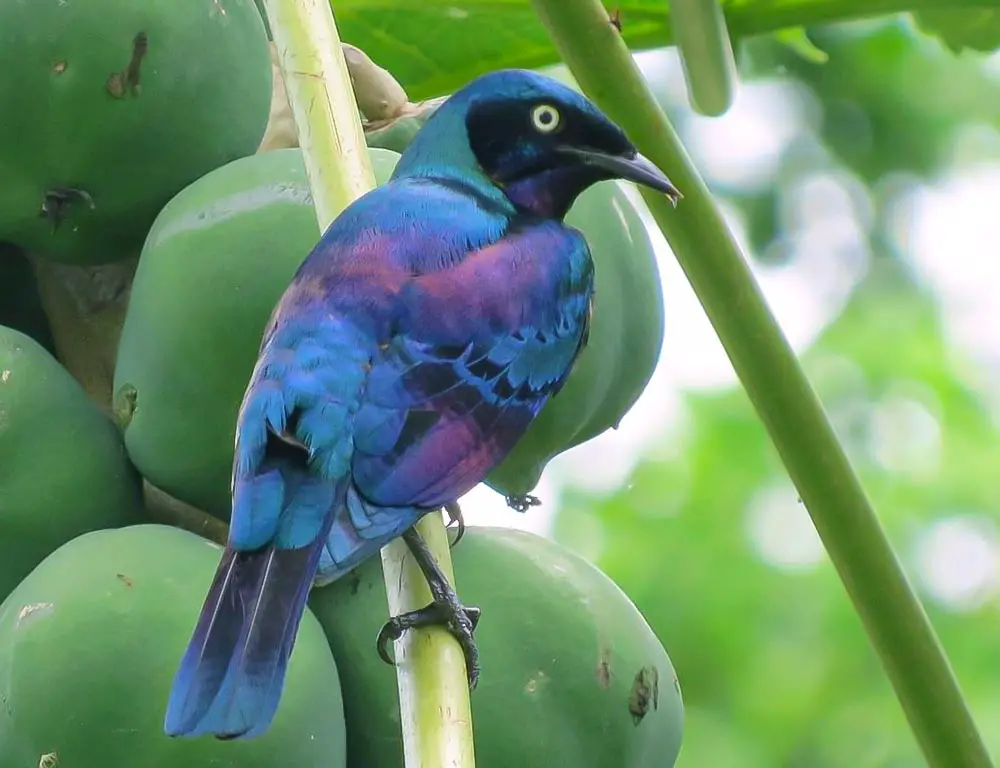
The Principe starling is an endemic species found only on the São Tomé and Príncipe islands. It is a member of the Sturnidae family, commonly referred to as glossy starlings or mynas.
This bird has a beautiful plumage that can be seen in both its dorsal view (backside) and ventral view (underside).
Its natural habitat consists mainly of subtropical or tropical moist lowland forests where it prefers perching atop trees high above ground level.
They are typically quite active during twilight hours when they go out foraging for food, such as small insects, fruits, and flower nectar.
The Principe Starling is generally silent but may produce loud vocalizations while nesting season approaches and occasionally whilst traveling in flocks across their range boundaries in search of new feeding grounds.
Scientific classification:
| Kingdom | Animalia |
| Phylum | Chordata |
| Class | Aves |
| Order | Passeriformes |
| Family | Sturnidae |
| Genus | Lamprotornis |
| Species | L. ornatus |
12. São Tomé Ibis
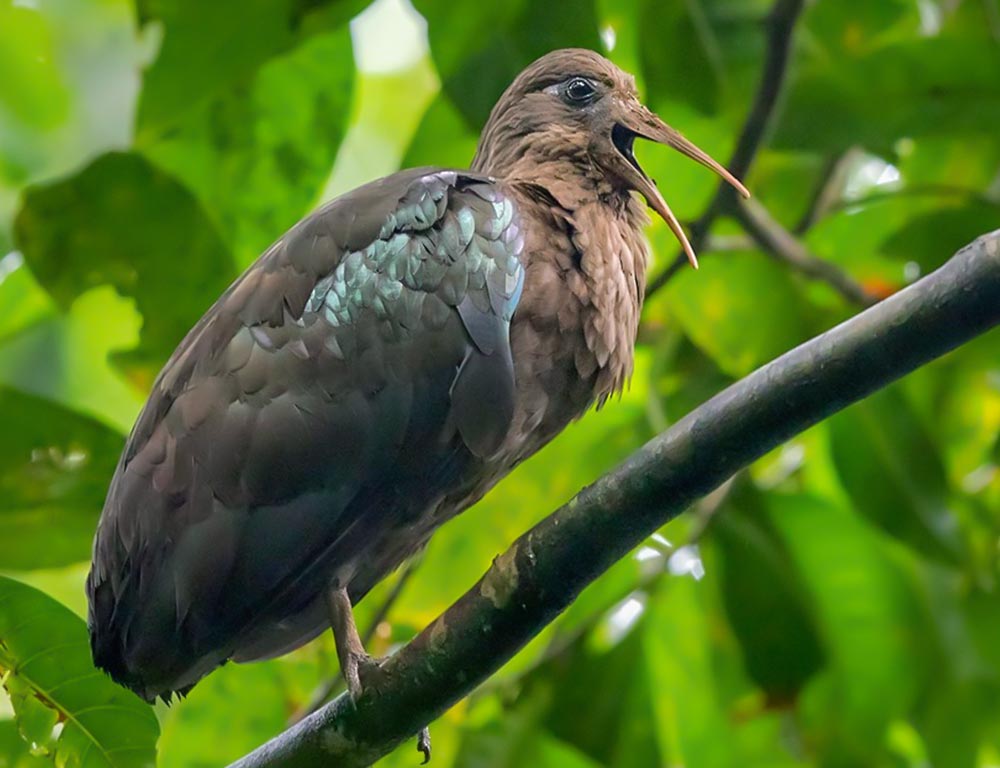
The São Tomé ibis, also known as the Dwarf Olive or Dwarf Ibis, is a critically endangered species native to São Tomé island off the western coast of Central Africa.
Discovered in the 1800s by Francisco Newton, it was initially thought to be related to larger olive ibises but is now recognized as its own distinct species.
It has an overall dark-brown coloration and white underparts with black feathers on its head and wings.
Its diet consists mainly of small invertebrates such as insects and worms found along rivers and streams on the island. Unfortunately, due to human activities like deforestation, their habitats quickly disappear, making them even more vulnerable than before.
Therefore, conservation efforts must take place in order for these birds to persist into future generations.
Scientific classification:
| Kingdom | Animalia |
| Phylum | Chordata |
| Class | Aves |
| Order | Pelecaniformes |
| Family | Threskiornithidae |
| Genus | Bostrychia |
| Species | B. bocagei |
13. São Tomé Oriole
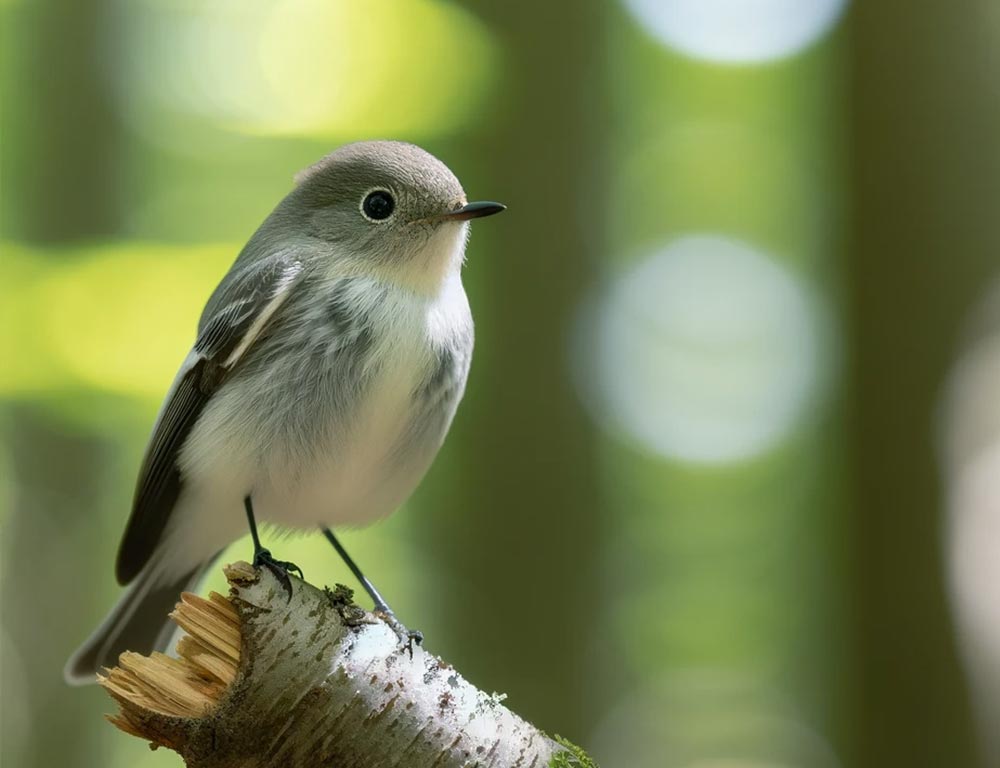
The São Tomé oriole, also known as the great-billed oriole, is a species of bird in the family Oriolidae native to the island of São Tomé.
It was named by Gustav Hartlaub in 1857 and can be found living in subtropical or tropical moist lowland forests and montane forests. Unfortunately, this beautiful bird is threatened due to habitat loss, which has made it vulnerable to extinction.
Its bright yellow feathers have black streaking on their wings, making it visually stunning when seen up close. The São Tomé oriole feeds mainly on insects but occasionally eats fruit from trees.
This charming little creature plays an important role within its ecosystem, so we must do our best to protect their habitats for generations to come.
Scientific classification:
| Kingdom | Animalia |
| Phylum | Chordata |
| Class | Aves |
| Order | Passeriformes |
| Family | Oriolidae |
| Genus | Oriolus |
| Species | O. crassirostris |
14. São Tomé White-Eye
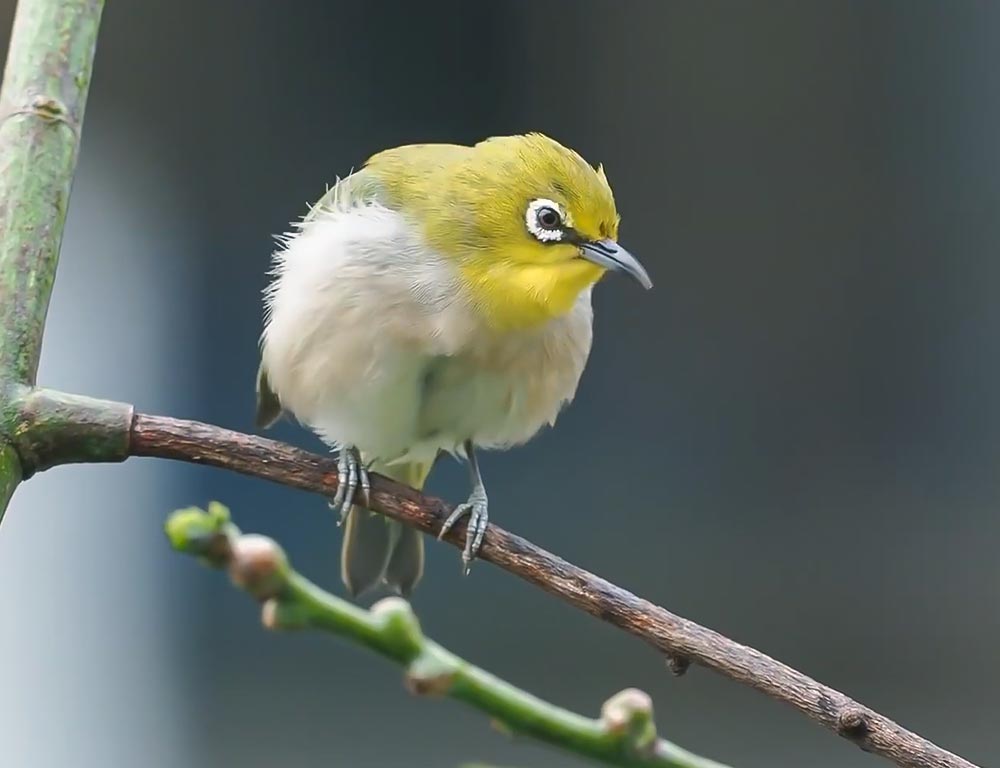
The São Tomé white-eye is a species of bird that is endemic to the island of São Tomé. It was named by Italian Tommaso Salvadori in 1901 and belongs to the family Zosteropidae.
This beautiful creature can be found in mid-to-high altitude forests, where it feeds on insects, fruits, and nectar from flowers.
Unfortunately, its population has been decreasing due to habitat loss; therefore conservation efforts are being done for this endangered species: reforestation programmes have been implemented as well as research initiatives which aim at understanding better their behaviour and ecology so appropriate measures can be taken in order to protect them effectively.
Scientific classification:
| Kingdom | Animalia |
| Phylum | Chordata |
| Class | Aves |
| Order | Passeriformes |
| Family | Zosteropidae |
| Genus | Zosterops |
| Species | Z. feae |
15. São Tomé Green Pigeon
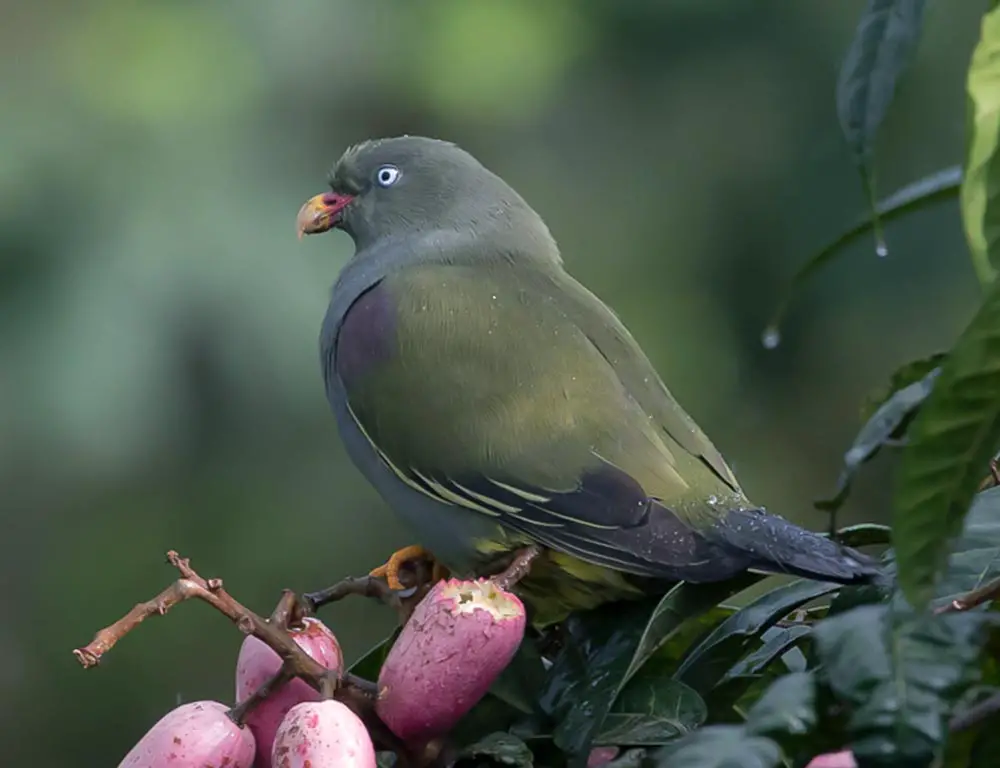
The São Tomé green pigeon is a species of bird found in the family Columbidae and endemic to the island of São Tomé. It has a beautiful emerald-green plumage with chestnut wings and tail.
Its natural habitat is moist lowland forests, but it has disappeared from Ilhéu das Rolas due to habitat loss. An estimated 10,000 pigeons remain on this small African island nation today.
They feed mainly on fruits like figs or berries that can be found near their nesting sites in tall trees or shrubs close to water courses for easy access when searching for food during dry periods.
The birds have adapted well despite human activities such as logging, which caused some destruction to its environment; however, they remain vulnerable due to their limited population size, so protecting them against further threats should be considered an urgent priority.
Scientific classification:
| Kingdom | Animalia |
| Phylum | Chordata |
| Class | Aves |
| Order | Columbiformes |
| Family | Columbidae |
| Genus | Treron |
| Species | T. sanctithomae |
16. Chestnut-Winged Starling
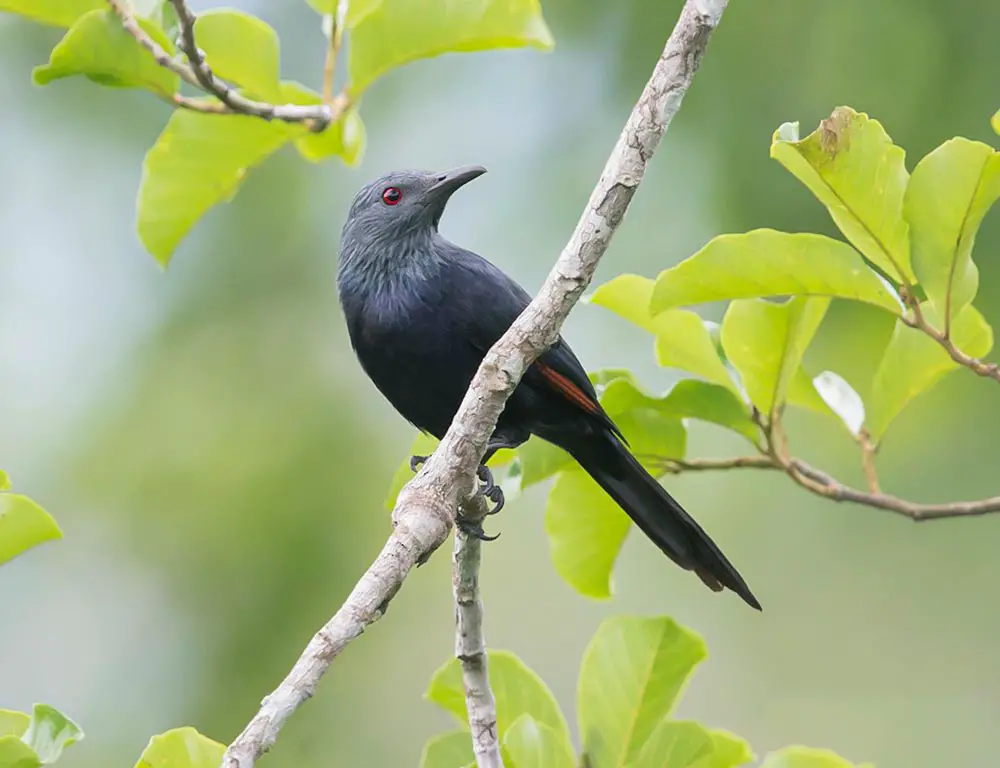
The Chestnut-winged Starling is a species of starling found across parts of Africa. It has blueish feathers, chestnut wings, and a tail, giving it its name.
This bird loves to forage around the ground for food like spiders, insects, seeds, and grains.
They usually form small flocks but can also be seen on their own in trees or shrubs during cooler seasons when they are not breeding or migrating.
During mating season, the male will sing complex melodies from high up in treetops as part of courtship rituals.
Even though this beautiful little bird is widespread throughout Africa, there are still some threats that could cause populations to decline, such as habitat loss due to deforestation and capture for illegal pet trade markets, so it’s important we protect these birds now before it’s too late.
Scientific classification:
| Kingdom | Animalia |
| Phylum | Chordata |
| Class | Aves |
| Order | Passeriformes |
| Family | Sturnidae |
| Genus | Onychognathus |
| Species | O. fulgidus |
17. African Emerald Cuckoo
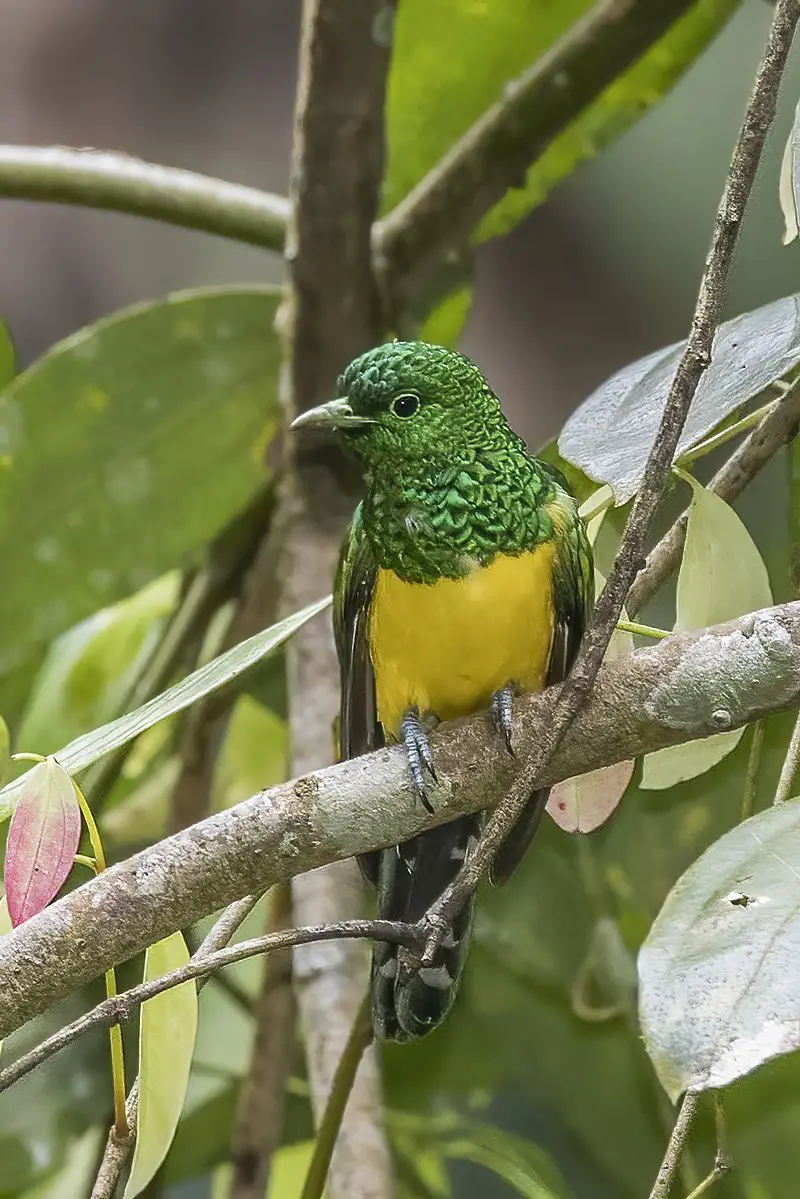
The African emerald cuckoo is a species of Old World cuckoo that can be found across much of sub-Saharan Africa.
It has four unique subspecies, C.c. cupreus, C.c sharpie, C.c intermedius, and insular, which have adapted to their respective areas in the continent over time and are distinguishable by minor differences such as size or plumage coloration.
This bird feeds mainly on arthropods but will also consume fruit from trees like mangoes when available during its breeding season, spanning from December to April, depending upon location.
The female lays eggs directly into other birds’ nests without them knowing for it raise her own young with no effort required by her; this behavior gives the species its name ‘Cuckoo’ as it is thought to mimic the sound made by these birds within their habitat.
Scientific classification:
| Kingdom | Animalia |
| Phylum | Chordata |
| Class | Aves |
| Order | Cuculiformes |
| Family | Cuculidae |
| Genus | Chrysococcyx |
| Species | C. cupreus |
18. Black-Capped Speirops
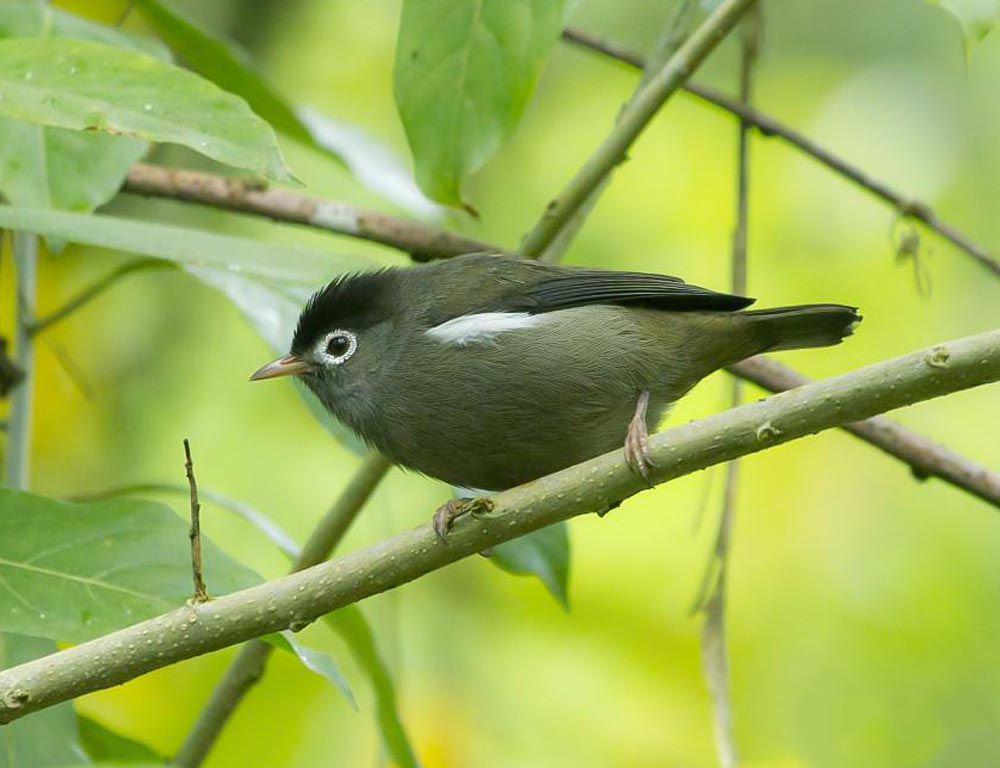
The Black-capped speirops is a species of bird found only in the island nation of São Tomé and Príncipe. It belongs to the family Zosteropidae and was previously placed under the genus Speirops.
This small passerine bird has an olive green back and yellowish throat with a black cap on its head. Its wings are patterned with white stripes, making it distinct from other family members.
The diet consists mainly of insects but may also include fruits and nectar from flowers when available.
As this species is endemic to just one country, conservation efforts should be increased to ensure that these birds do not become extinct due to habitat destruction or climate change impacts like increasing temperatures and changing weather patterns.
Scientific classification:
| Kingdom | Animalia |
| Phylum | Chordata |
| Class | Aves |
| Order | Passeriformes |
| Family | Zosteropidae |
| Genus | Zosterops |
| Species | Z. lugubris |
19. Bronze Mannikin
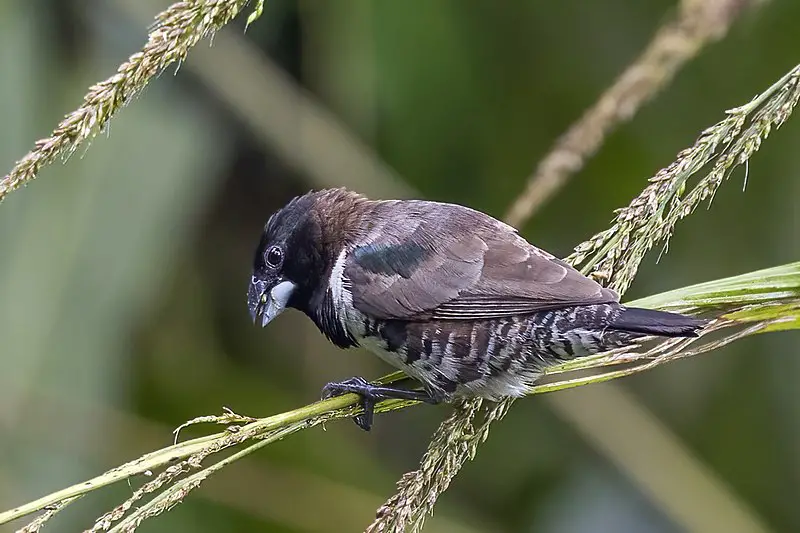
The Bronze Mannikin is a small passerine bird that lives in the Afrotropic region. It’s uncommon for locally abundant species to be found south of the Sahara Desert, usually inhabiting mesic savanna or forest margins.
With its estimated 8,100,000 km2 global range of occurrence, it can be quite common in some places and rare in others.
This social finch loves being around people and other birds; it has even been known to join mixed flocks alongside larks and pipits.
Its vibrant feathers make for a stunning sight as it perches on tree branches, singing joyfully throughout the day.
Scientific classification:
| Kingdom | Animalia |
| Phylum | Chordata |
| Class | Aves |
| Order | Passeriformes |
| Family | Estrildidae |
| Genus | Spermestes |
| Species | S. cucullata |
20. Blue-Breasted Kingfisher
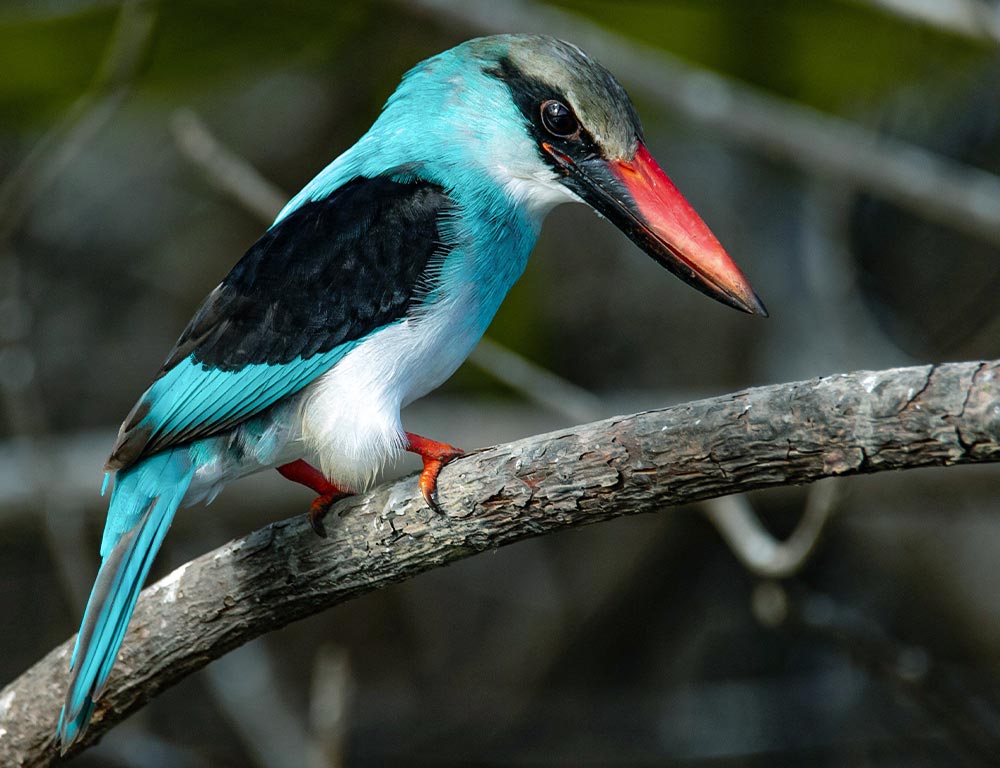
The Blue-breasted Kingfisher is a striking species of bird native to Equatorial Africa. Measuring 25 cm in length, this tree kingfisher has bright blue feathers on its head, back, wings, and tail.
Its underparts are white with a contrasting blue breast band for added visual interest.
Though essentially resident there, it does migrate from drier savannas to wetter habitats during the dry season in order to survive better.
This species feeds mainly on insects such as beetles and grasshoppers but will also take small fish when available near the shorelines or riverside vegetation they inhabit.
The beautiful song of these birds can often be heard echoing through their natural environment – an unmistakable sound that makes them easily recognizable.
Scientific classification:
| Kingdom | Animalia |
| Phylum | Chordata |
| Class | Aves |
| Order | Coraciiformes |
| Family | Alcedinidae |
| Subfamily | Halcyoninae |
| Genus | Halcyon |
| Species | H. malimbica |
21. Príncipe Speirops
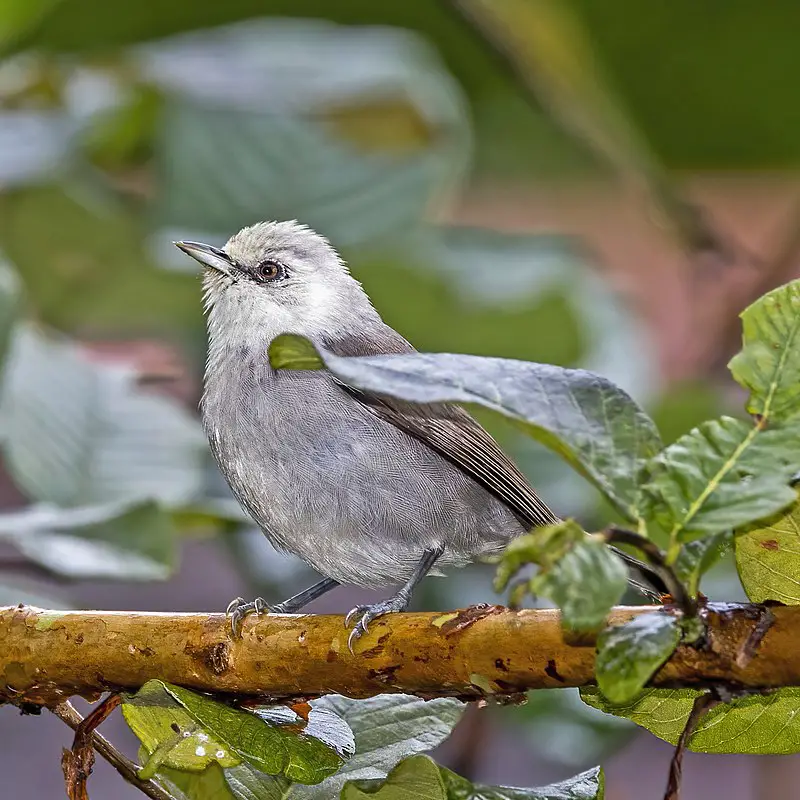
The Príncipe speirops is a species of bird that can only be found on the island of Príncipe in São Tomé and Príncipe. It belongs to the Zosteropidae family, which is usually located in subtropical or tropical moist lowland forests and plantations.
Unfortunately, due to habitat loss, this species is considered threatened. This small passerine has grey plumage with black wings, tips, and white spots all over its body and yellow-orange legs and feet.
The upperparts have a pale olive hue while the underparts are whiter with more intense spotting on their chest area; males also feature darker lores than females do.
They feed mainly on insects but will also eat nectar when available during dry seasons since it helps them better survive scarcity periods.
Scientific classification:
| Kingdom | Animalia |
| Phylum | Chordata |
| Class | Aves |
| Order | Passeriformes |
| Family | Zosteropidae |
| Genus | Zosterops |
| Species | Z. leucophaeus |
22. Golden-Backed Bishop
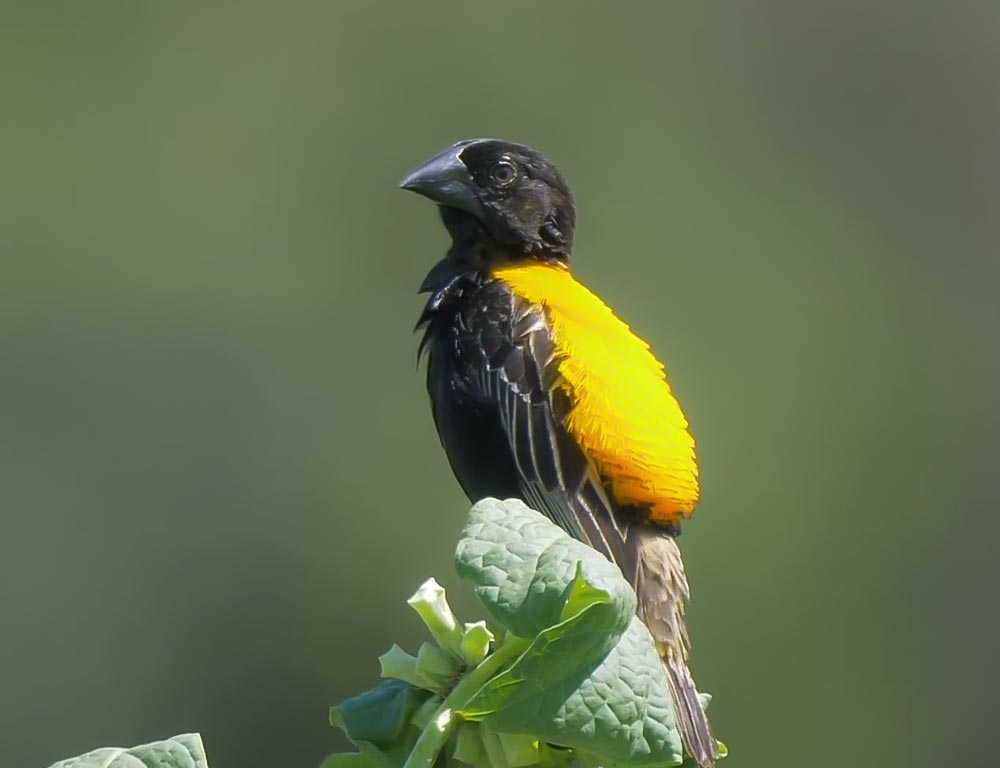
The golden-backed bishop is a species of bird found in western Angola and São Tomé Island. It belongs to the family Ploceidae, which contains many weaver birds.
Its body is yellowish with black markings on its wings and tail feathers. The most striking feature, however, are two bright patches of orange on its back that give it its name – ‘golden-backed’
This small, active bird spends much of its time gathering grasses and other materials for building nests in shrubs or trees near rivers and streams.
During the breeding season, they form colonies where males display their colorful plumage to attract mates and defend their territory from intruders.
Although not endangered, human activity such as deforestation could threaten this beautiful species’ survival if left unchecked.
Scientific classification:
| Kingdom | Animalia |
| Phylum | Chordata |
| Class | Aves |
| Order | Passeriformes |
| Family | Ploceidae |
| Genus | Euplectes |
| Species | E. aureus |
23. Stone-Curlew

Stone-curlews, also known as dikkops or thick-knees, are a family of birds that have adapted to live in tropical and temperate regions worldwide.
They can be found in Africa, Asia, and Australia, with two or more species per region. Despite being classified as waders, most prefer dry, arid habitats over moist wetlands.
Stone curlews typically have long legs, which help them navigate through their preferred terrain efficiently; some species even stand at impressive heights when standing on those long legs.
Additionally, they feature cryptic plumage, which helps them blend into their surroundings while hunting for prey such as insects and small mammals like rodents.
These unique birds’ calls are easily recognizable; it has been said that hearing one is similar to listening to someone whistling ‘Keee We.’
Scientific classification:
| Kingdom | Animalia |
| Phylum | Chordata |
| Class | Aves |
| Order | Charadriiformes |
| Suborder | Chionidi |
| Family | Burhinidae Mathews, 1912 |
24. Threskiornithidae
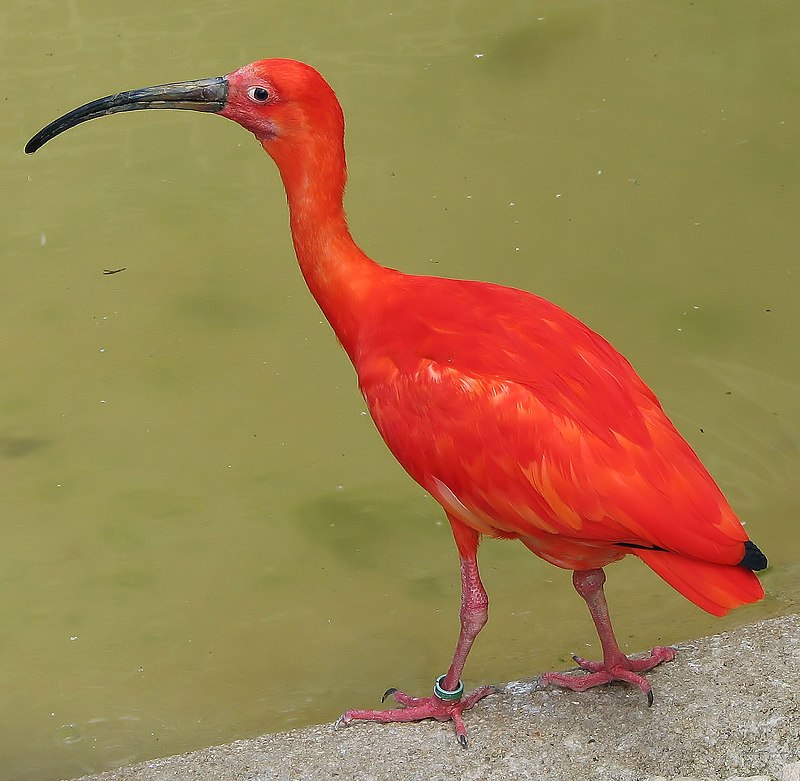
Threskiornithidae is a family of large wading birds which includes 36 species. These birds are traditionally divided into two subfamilies – the ibises and the spoonbills.
However, recent genetic analysis has shown that spoonbills actually belong to the Old World ibis group, while New World ibises form an early offshoot from this lineage.
Threskiornithidse members have long curved beaks with serrated edges used for catching fish in shallow water or mudflats and other aquatic invertebrates like crustaceans and mollusks.
They also feed on plant matter, such as grains and seeds found close to wetlands areas where they live.
This diverse diet makes them important scavengers in their ecosystems, helping maintain healthy native wildlife populations by controlling insect numbers and dispersing energy-rich seeds throughout wetland habitats.
Scientific classification:
| Kingdom | Animalia |
| Phylum | Chordata |
| Class | Aves |
| Order | Pelecaniformes |
| Suborder | Ardei |
| Family | Threskiornithidae Richmond, 1917 |
25. Glareolidae
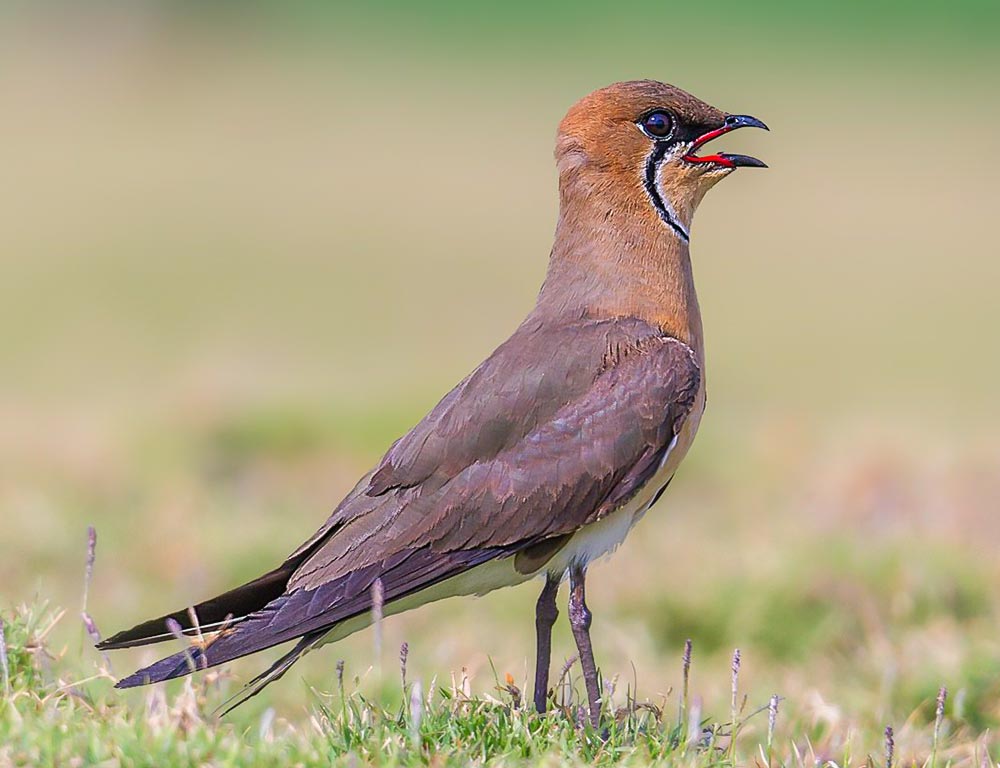
Glareolidae is a family of wading birds consisting of four genera and 17 species. They are distinguished from other charadrii by their long bills, which have a slight downward curve.
Glareolidae live around open grasslands and deserts, where they hunt for insects using the bill to probe into soil or vegetation.
Most species are found in Africa, but two pratincoles also inhabit parts of Europe and Asia.
Courses are larger than pratincoles and have longer legs, allowing them to run quickly across sandy dunes while feeding on small animals like lizards or spiders.
Pratincoles feed mainly on flying insects, snatching them out of midair with great agility during flight.
All glareolids share unique features, such as large eyes that help them spot prey at night easily, making this group one interesting bird family.
Scientific classification:
| Kingdom | Animalia |
| Phylum | Chordata |
| Class | Aves |
| Order | Charadriiformes |
| Suborder | Lari |
| Family | Glareolidae CL Brehm, 1831 |
26. African Rail
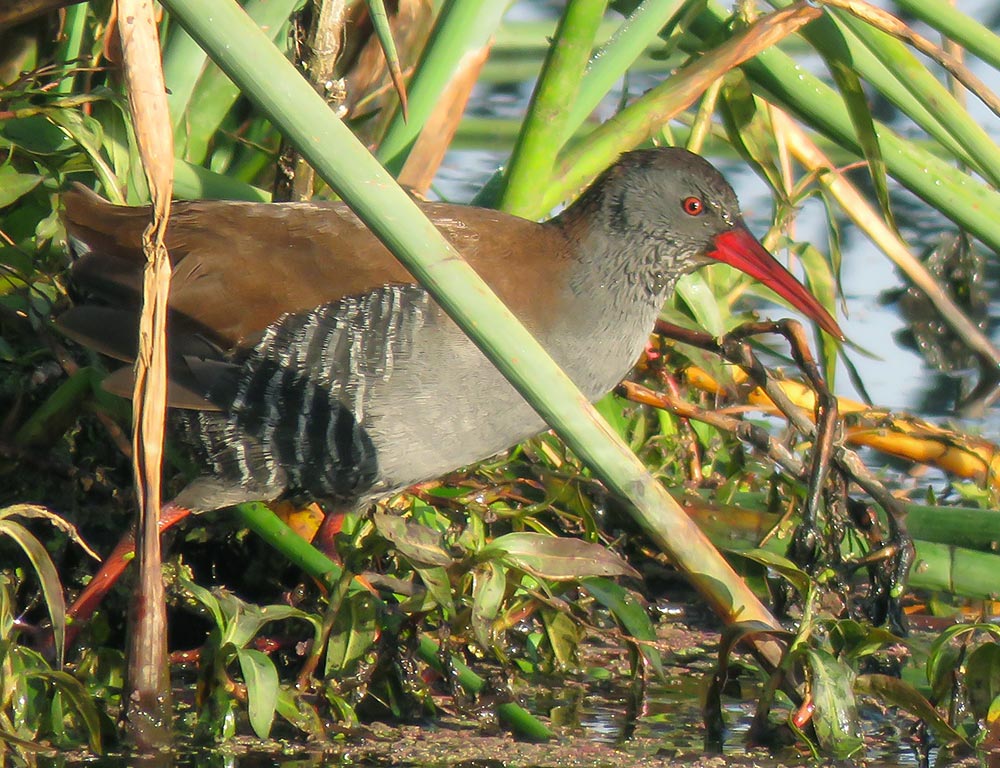
The African rail is a small, wetland bird of the rail family that can be found in eastern and southern Africa.
It was formally described by Johann Friedrich Gmelin in 1789 as part of his revised edition of Carl Linnaeus’s Systema Naturae.
This species has an olive-brown to blackish color with white stripes on its back, wings, and tail feathers.
Its legs are yellow or orange colored, and it has a short bill which is gray or brown above with red at the base below.
The African Rail feeds mainly on aquatic invertebrates such as insects, crustaceans, mollusks, and worms but will also take some plant matter when available.
They usually live in marshes near water bodies where they build their nests between dense vegetation for protection from predators such as snakes and birds of prey like owls, hawks & eagles.
Scientific classification:
| Kingdom | Animalia |
| Phylum | Chordata |
| Class | Aves |
| Order | Gruiformes |
| Family | Rallidae |
| Genus | Rallus |
| Species | R. caerulescens |
27. Monarch Flycatcher
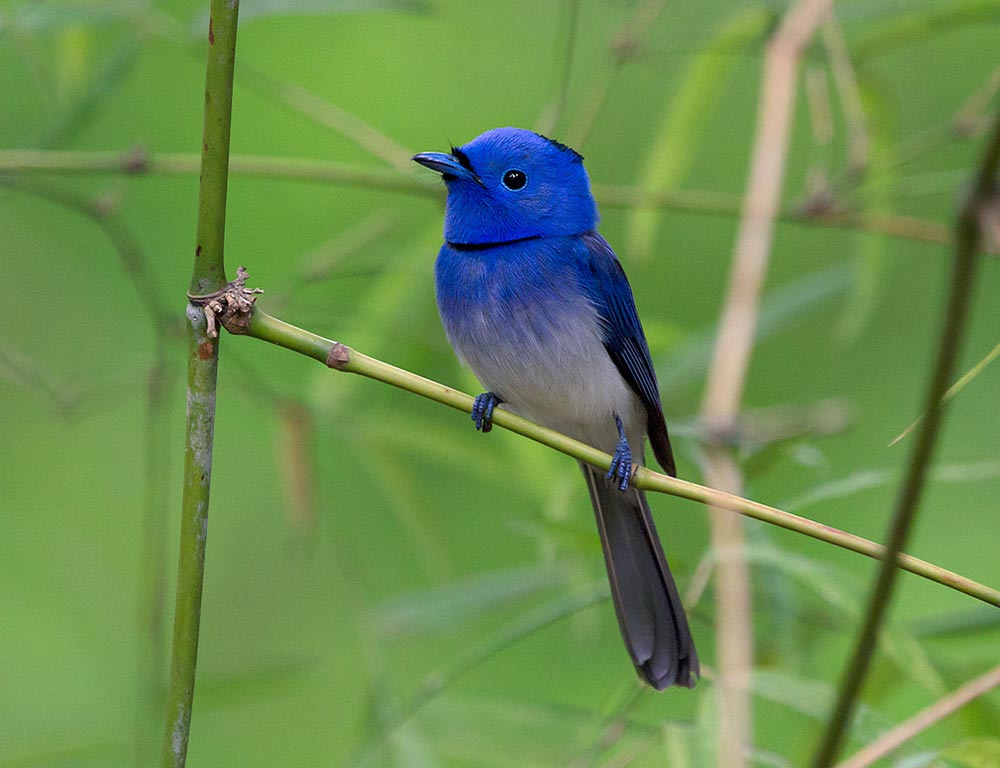
The Monarch flycatcher is a small passerine bird belonging to the family Monarchidae. It inhabits forest or woodland areas across sub-Saharan Africa, Southeast Asia, Australasia, and various Pacific islands.
Only some species migrate seasonally. This beautiful little bird has a long tail and feeds mainly on insects it catches in its beak.
Its cup-shaped nest can often be found hanging from branches high up in trees where they are safe from predators while incubating their eggs – usually between two and four of them at once.
The adult birds have attractive plumage with hues of blues and greens and white patches near their tails, making for stunning displays when they take flight during mating season or migratory times.
Scientific classification:
| Kingdom | Animalia |
| Phylum | Chordata |
| Class | Aves |
| Order | Passeriformes |
| Superfamily | Corvoidea |
| Family | Monarchidae Bonaparte, 1854 |
28. Island Bronze-Naped Pigeon
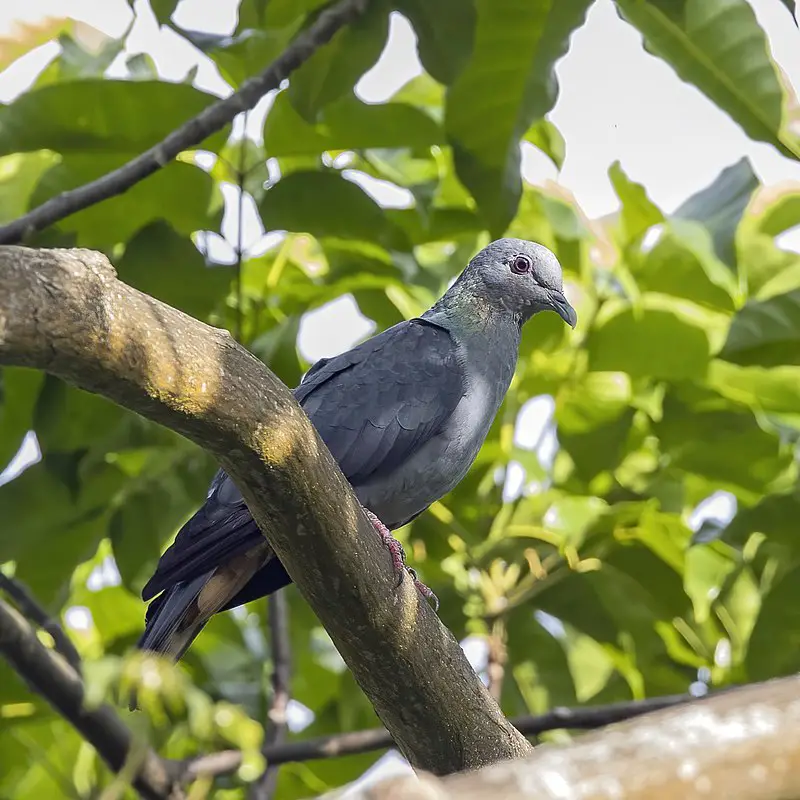
The Island bronze-naped pigeon is a species of bird found in the Gulf of Guinea islands, restricted to Annobón (Equatorial Guinea), São Tomé and Príncipe.
It belongs to the subgenus Turturoena within the Columbidae family. This beautiful bird has mottled brown feathers with a bronzy nape patch on its neck.
Its natural habitat is lowland forests that are either subtropical or tropical moist areas, but it can also be seen in agricultural fields too close to these habitats foraging for food like fruits and seeds and invertebrates from time to time.
Although it faces threats due to a decline in available habitat and hunting pressure, this species still manages to sustain itself thanks mainly to healthy population numbers across its range.
Scientific classification:
| Kingdom | Animalia |
| Phylum | Chordata |
| Class | Aves |
| Order | Columbiformes |
| Family | Columbidae |
| Genus | Columba |
| Species | C. malherbii |
29. Lemon Dove
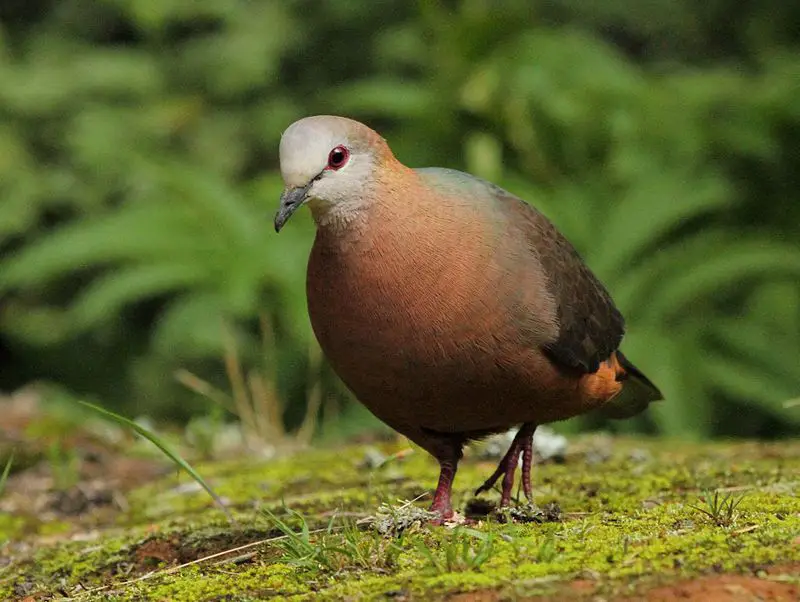
The Lemon Dove is a bird species in the Columbidae family, found mainly in sub-Saharan Africa.
This dove has an overall brownish-grey plumage with a cinnamon brown breast and greenish gloss on its neck – males have additional white markings on their head.
Females and juveniles are more mottled than adult birds, making them less visible to predators while they search for food under leaves or branches.
The São Tomé lemon dove is usually considered a separate subspecies due to slight differences in coloration or size; however, both share similar habits, such as nesting high up among trees rather than close to ground level like other doves.
They feed mainly on fruits and seeds that grow amongst tree canopies but will also eat snails when available during wetter seasons.
Scientific classification:
| Kingdom | Animalia |
| Phylum | Chordata |
| Class | Aves |
| Order | Columbiformes |
| Family | Columbidae |
| Genus | Columba |
| Species | C. larvata |
30. White-Bellied Kingfisher
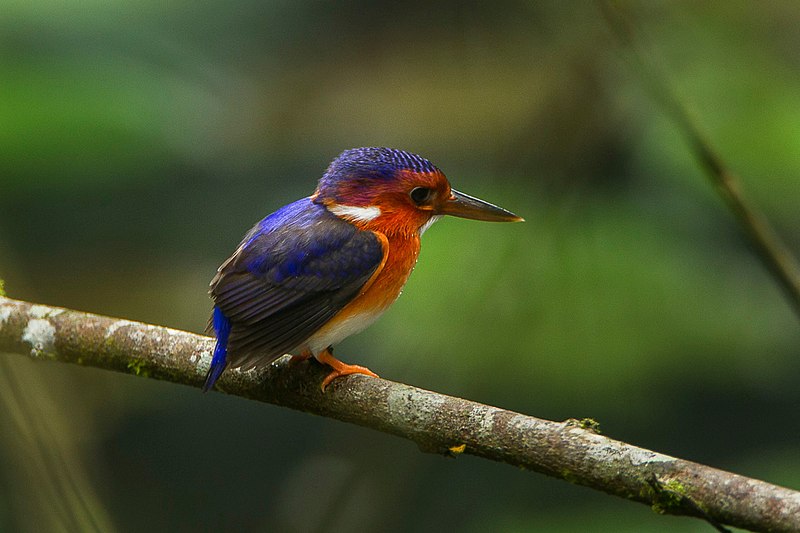
The White-bellied Kingfisher is a species of kingfisher found in parts of equatorial West Africa. It has three subspecies and can reach up to 13 cm (5.1 inches) in length with an 18–20 cm (7.1–7.9 inch) wingspan when fully grown.
This bird exhibits vibrant colors on its body, including white underparts, dark blue upperparts, yellow collar, tail feathers, and red bill and legs, which add to its beauty.
Its diet consists mainly of insects such as beetles, grasshoppers, and caterpillars, but it also eats small fish or frogs near rivers or streams if available. Nearby food sources are scarce during the dry season when insect populations decline significantly.
The White-bellied Kingfisher usually nests inside tree holes, although they may sometimes occupy abandoned woodpecker cavities instead for nesting purposes.
This helps them stay safe from predators such as snakes due to their considerable size compared with smaller birds like warblers or sparrows.
Scientific classification:
| Kingdom | Animalia |
| Phylum | Chordata |
| Class | Aves |
| Order | Coraciiformes |
| Family | Alcedinidae |
| Subfamily | Alcedininae |
| Genus | Corythornis |
| Species | C. leucogaster |
31. Blue Waxbill
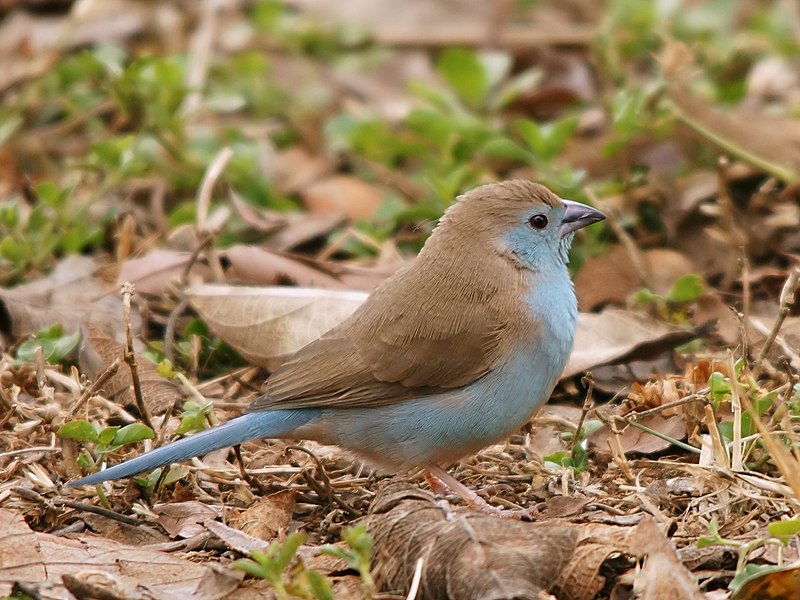
The Blue Waxbill is a species of estrildid finch native to Southern Africa, and it is also quite popular in aviary bird-keeping.
It features blue feathers on its head and throat and a bright orange breast – giving it the “cordon-bleu” name.
This small songbird has an average length of 5 inches and can be found amongst shrubs or grassland habitats near water sources such as rivers or lakes.
The diet typically consists mainly of seeds supplemented by insects for additional nutrients during the breeding season.
They are usually seen in pairs or family groups, which become highly territorial during nesting time; they build their nests using fine blades of grass woven together with spider webs.
Despite being heavily hunted by humans for meat consumption purposes, this beautiful bird population continues to thrive today thanks to conservation efforts.
Scientific classification:
| Kingdom | Animalia |
| Phylum | Chordata |
| Class | Aves |
| Order | Passeriformes |
| Family | Estrildidae |
| Genus | Uraeginthus |
| Species | U. angolensis |
Also Featured In: Blue Birds You’ll Found around Us, Birds that You’ll Find in Kruger national park
32. Red-Headed Quelea
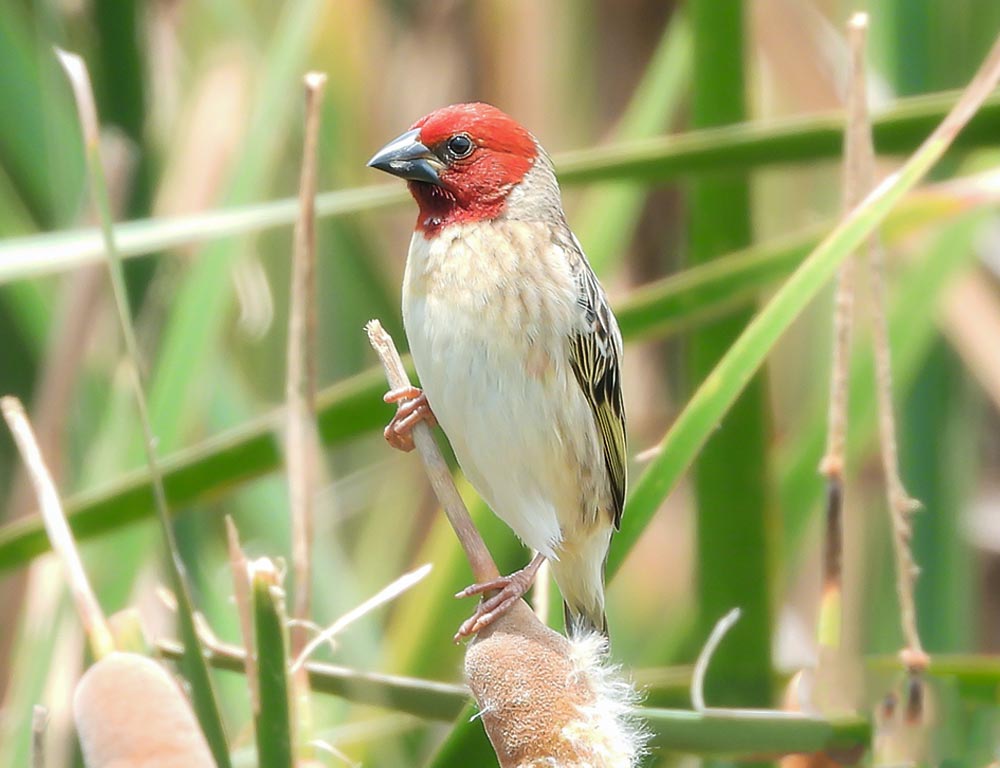
The red-headed quelea is a species of bird found in many African countries. It has distinctive red plumage on its head, which gives it an unmistakable look from other birds.
Its scientific name, Quelea erythrops, means ‘red face’. They usually inhabit savannas and grasslands but can also be seen near rivers or lakes.
They feed mainly on insects such as caterpillars and grasshoppers but will occasionally eat seeds, too. Red-headed queleas form large flocks that contain hundreds or even thousands of individuals.
These flocks often migrate over long distances during the dry season to find food sources more easily. With their striking appearance and social behavior, they are one of the fascinating birds in Africa.
Scientific classification:
| Kingdom | Animalia |
| Phylum | Chordata |
| Class | Aves |
| Order | Passeriformes |
| Family | Ploceidae |
| Genus | Quelea |
| Species | Q. erythrops |
33. São Tomé Scops Owl
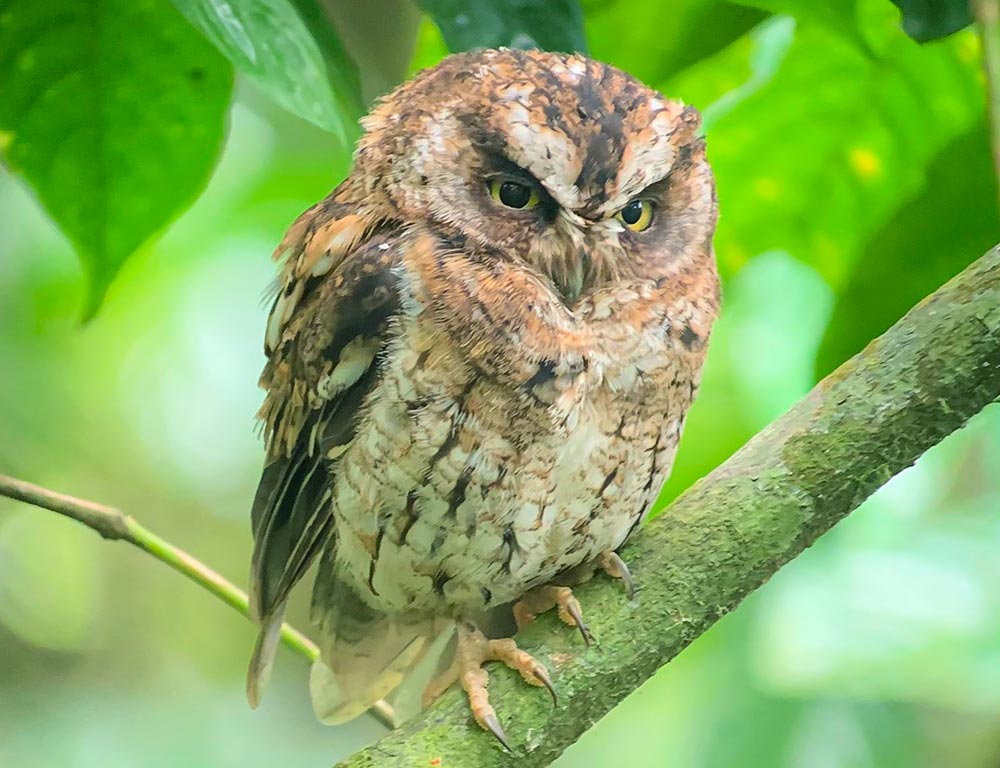
The São Tomé scops owl is an enigmatic little bird native to the island of São Tomé and Príncipe in the Gulf of Guinea.
It has a reddish-brown facial disc with a white chin, eyebrows, and small ear tufts, giving it an unusual look.
Its wings are rounded at their tips when spread out, and its tail is long and barred with dark brown feathers on top.
The plumage across its body varies from light buffy grey to rufous-brown above, while underside feathers range from yellowish or whitish shades to tawny or cinnamon hues.
This species prefers undisturbed primary forest habitats for roosting during the day but also hunts in open areas near water sources such as riversides at night time.
It may be threatened by habitat loss due to agricultural expansion if conservation measures aren’t implemented soon enough.
Scientific classification:
| Kingdom | Animalia |
| Phylum | Chordata |
| Class | Aves |
| Order | Strigiformes |
| Family | Strigidae |
| Genus | Otus |
| Species | O. hartlaubi |
34. São Tomé Shorttail
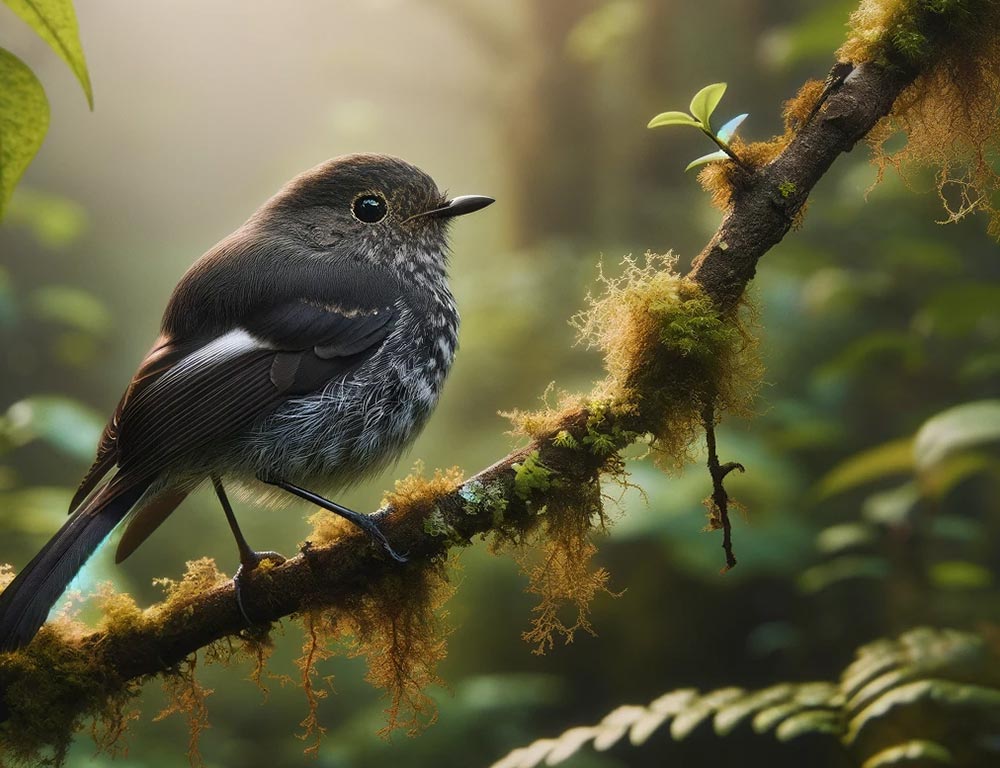
The São Tomé shorttail is a passerine bird species belonging to the Motacillidae family. It is endemic to the central and southern parts of São Tomé island in Africa.
This small songbird has an olive-green back with whitish underparts and a long bill that distinguishes it from other members of its genus.
Its habitat includes subtropical or tropical moist lowland forests as well as plantations, cultivated fields, gardens, and shrublands near rivers or streams.
These birds feed on insects found among foliage or near water sources such as ponds, lakes, and marshes; they also eat fruit nectar when available seasonally.
The conservation status for this species is currently listed as Near Threatened due to loss of habitat caused by human activities like farming expansion and urbanization – but hopefully, through public awareness campaigns, these issues can be addressed before it’s too late.
Scientific classification:
| Kingdom | Animalia |
| Phylum | Chordata |
| Class | Aves |
| Order | Passeriformes |
| Family | Motacillidae |
| Genus | Motacilla |
| Species | M. bocagii |
35. Allen’s Gallinule
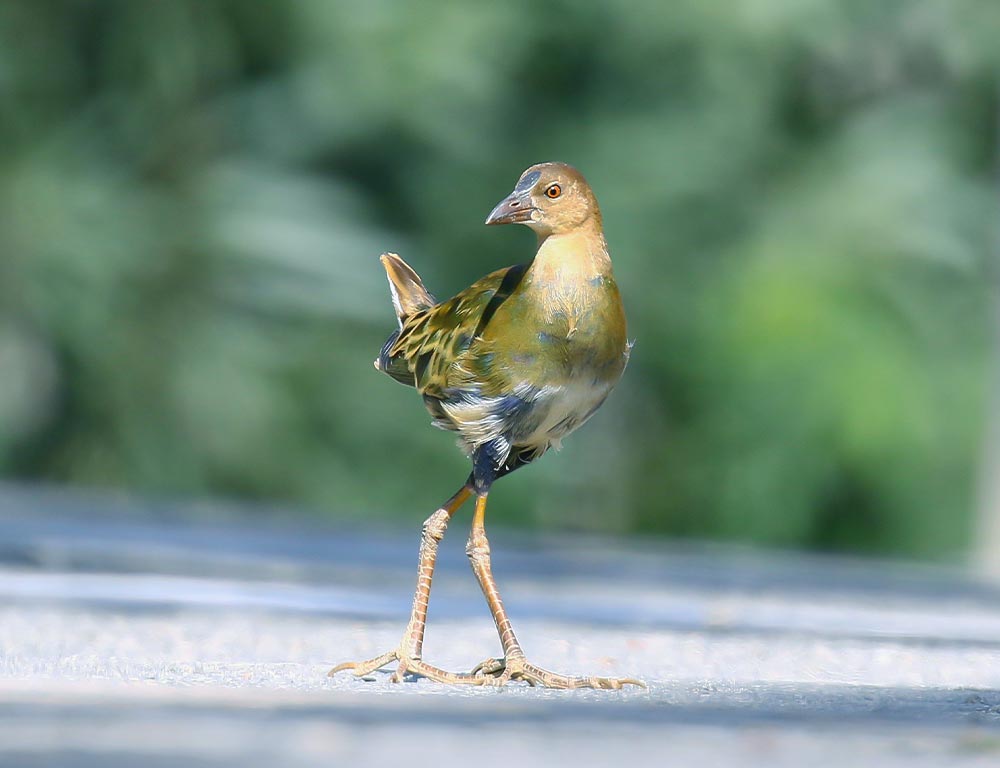
Allen’s gallinule is a small waterbird belonging to the family Rallidae. Its scientific name, Porphyrio alleni, commemorates British naval officer Rear-Admiral William Allen (1792–1864).
It breeds in marshes and lakes across Sub-Saharan Africa. The bird usually builds its nest on floating vegetation or platforms of reeds near water bodies.
It feeds mainly on aquatic plants, tadpoles, and insects that it finds while swimming in shallow waters or walking along the edges of wetlands.
They are highly social birds often seen foraging together with other species, such as moorhens and coots.
The male is identified by his bright blue bill, whereas females have brown bills with yellow tips during the breeding season, which helps them attract potential mates.
Allen’s Gallinules are quite vocal creatures, making loud alarm calls when threatened by predators like eagles or herons, which makes them interesting avian inhabitants of African wetlands.
Scientific classification:
| Kingdom | Animalia |
| Phylum | Chordata |
| Class | Aves |
| Order | Gruiformes |
| Family | Rallidae |
| Genus | Porphyrio |
| Species | P. alleni |
36. Bridled Tern
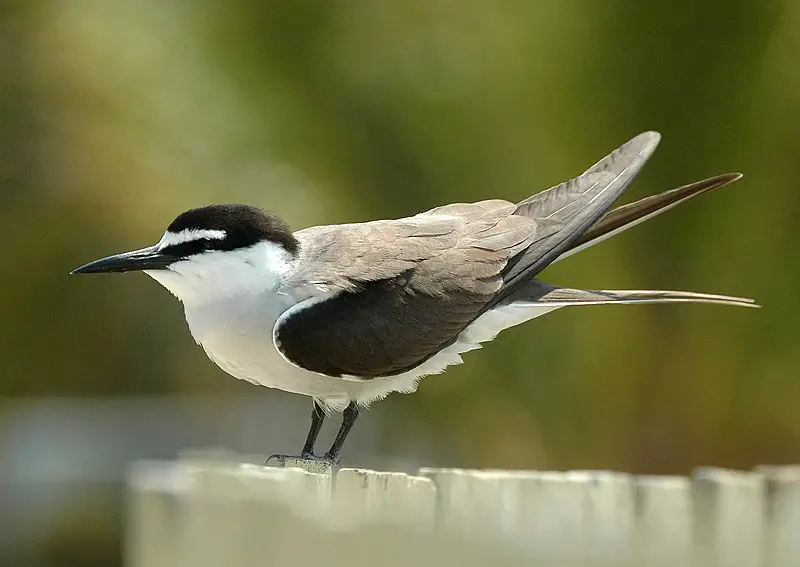
The Bridled Tern is a medium-sized seabird of the family Laridae, found in tropical oceans. It has an impressive wingspan of 77–81 cm and measures 30–32 cm in length, similar to the Common Tern.
Its scientific name originates from Ancient Greek: Onux, meaning “claw” or “nail”, and Prion, which translates as “saw”. The specific anaethetus means ‘senseless’ or ‘stupid’
These birds are elegant flyers with greyish brown upperparts and white underparts when they take off into flight, while their head appears black on top but turn to white below the eyes with a thin line between them.
Scientific classification:
| Kingdom | Animalia |
| Phylum | Chordata |
| Class | Aves |
| Order | Charadriiformes |
| Family | Laridae |
| Genus | Onychoprion |
| Species | O. anaethetus |
37. African Olive Pigeon
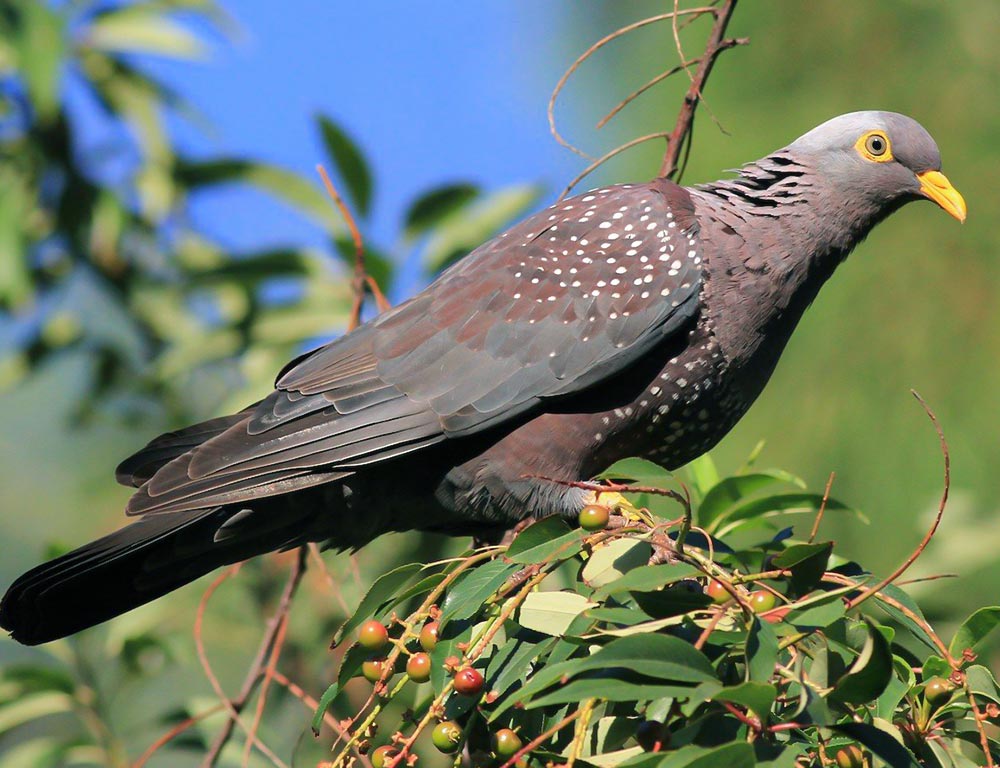
The African olive pigeon is a common resident of eastern and southern Africa and parts of Angola, Saudi Arabia, and Yemen.
It has beautiful gray-brown feathers with white spots on its wings.
The adult male bird displays an iridescent green neck patch, while the female lacks this distinctive coloration.
This species prefers open woodland areas or savannas, which feed primarily on seeds, fruits, and buds found in tall trees or shrubs.
When breeding, it builds a flimsy platform nest located high up in a tree canopy to lay two eggs, which hatch after 14 14-day incubation period by both parents caring for their young until fledging at around 28 days old.
Scientific classification:
| Kingdom | Animalia |
| Phylum | Chordata |
| Class | Aves |
| Order | Columbiformes |
| Family | Columbidae |
| Genus | Columba |
| Species | C. arquatrix |
38. White-Fronted Plover
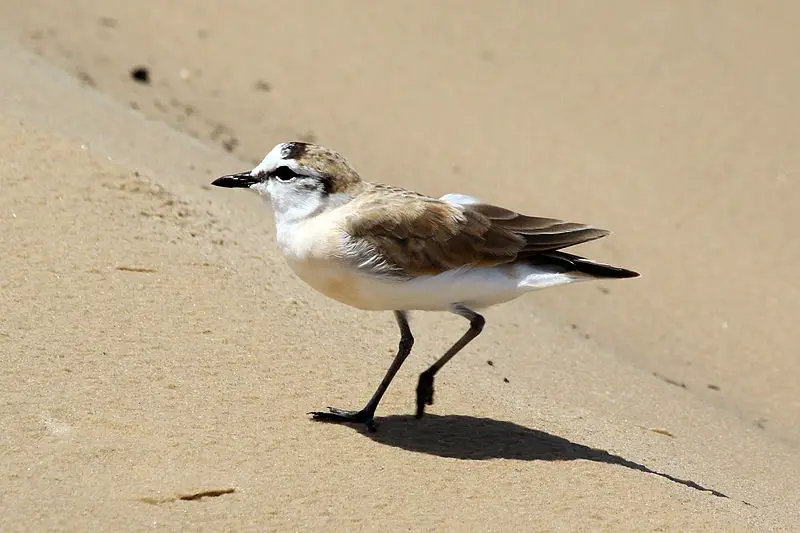
The White-fronted Plover is a small shorebird that inhabits sub-Saharan Africa and Madagascar. It has white feathers on its head and chest, gray wings, brown back, black lower belly, and legs.
Its diet consists of insects, crustaceans, mollusks, and worms found in the sand or mudflats along coasts or river banks.
The bird’s nesting behavior involves creating shallow scrapes in the ground to lay one to three eggs, which are then incubated by both parents for around 24 days before hatching.
This species of plover is monogamous, meaning it will form pairs for life and be quite long-lived, with an expected lifespan of up to 10 years.
Scientific classification:
| Kingdom | Animalia |
| Phylum | Chordata |
| Class | Aves |
| Order | Charadriiformes |
| Family | Charadriidae |
| Genus | Charadrius |
| Species | C. marginatus |
39. Chestnut-Breasted Nigrita
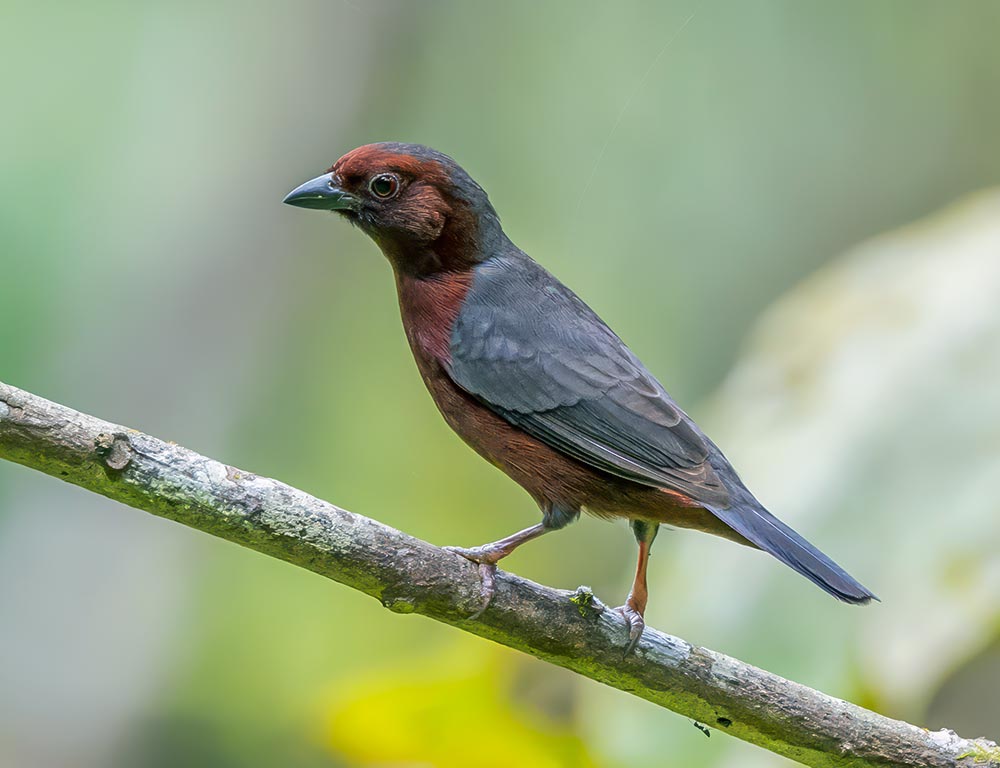
The Chestnut-breasted nigrita is a beautiful, common species of estrildid finch native to African tropical rainforests.
It has an extensive range and can be found in subtropical/tropical lowland forests, mangroves, and shrublands.
This bird has chestnut plumage on its upperparts with black wings and tail feathers. Its underparts are white with brown barring along the sides, giving it a striking appearance.
The stable population size makes this species evaluated as Least Concern by the IUCN Red List of Threatened Species.
Although not much studied yet, these birds live in flocks that feed mainly on seeds while they fly swiftly across their habitat, looking for food sources such as insects or fruits occasionally, too.
Scientific classification:
| Kingdom | Animalia |
| Phylum | Chordata |
| Class | Aves |
| Order | Passeriformes |
| Family | Estrildidae |
| Genus | Nigrita |
| Species | N. bicolor |
40. Banded Martin
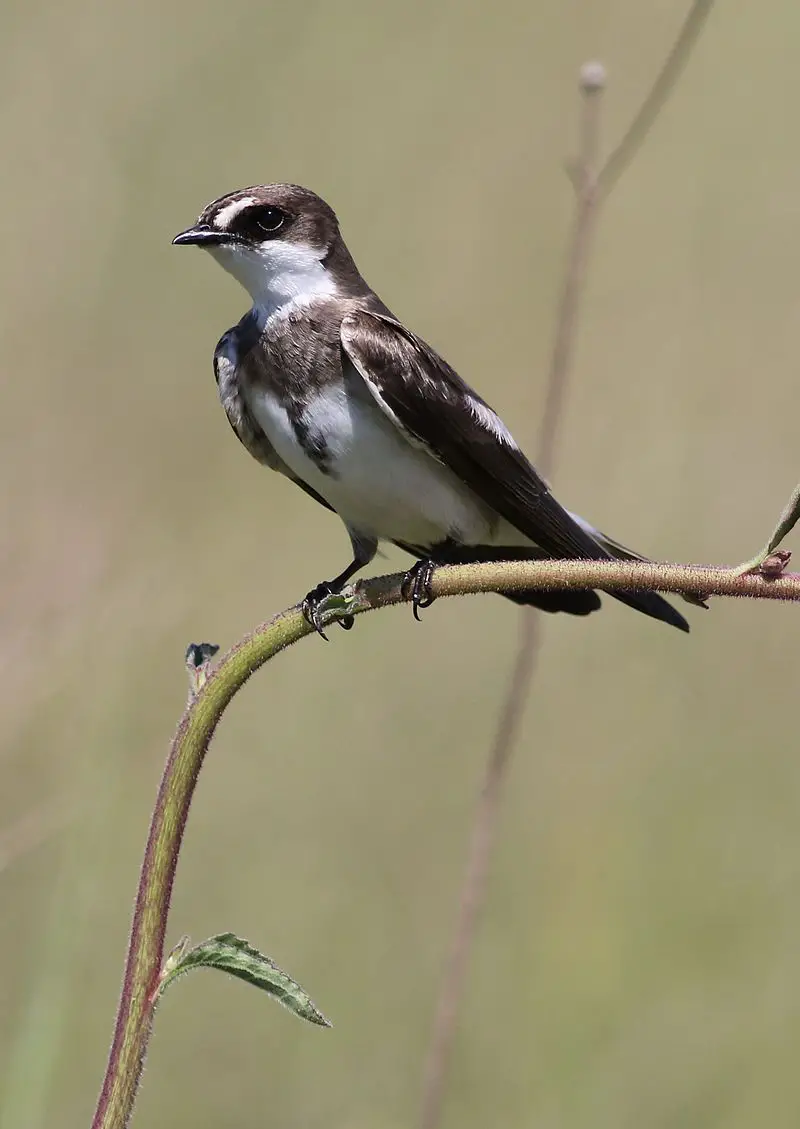
The Banded Martin is a small passerine bird that’s endemic to Africa and the only species of its genus Neophedina.
It was first described by French polymath Georges-Louis Leclerc in 1780 from a specimen collected at Cape of Good Hope.
This migratory bird has brownish upper parts, a white throat with black stripes, grey underparts, and tail feathers, which are dark grey on top and pale underneath.
These birds feed mainly on flying insects like termites during flight, or sometimes, they may catch prey while hovering over water surfaces before diving in for their food.
They can be seen near lakes or rivers where these birds breed in colonies between August – and September, making mud nests close to each other inside reed beds or beneath rocks.
Scientific classification:
| Kingdom | Animalia |
| Phylum | Chordata |
| Class | Aves |
| Order | Passeriformes |
| Family | Hirundinidae |
| Genus | Neophedina Roberts, 1922 |
| Species | N. cincta |
41. Red-Necked Spurfowl
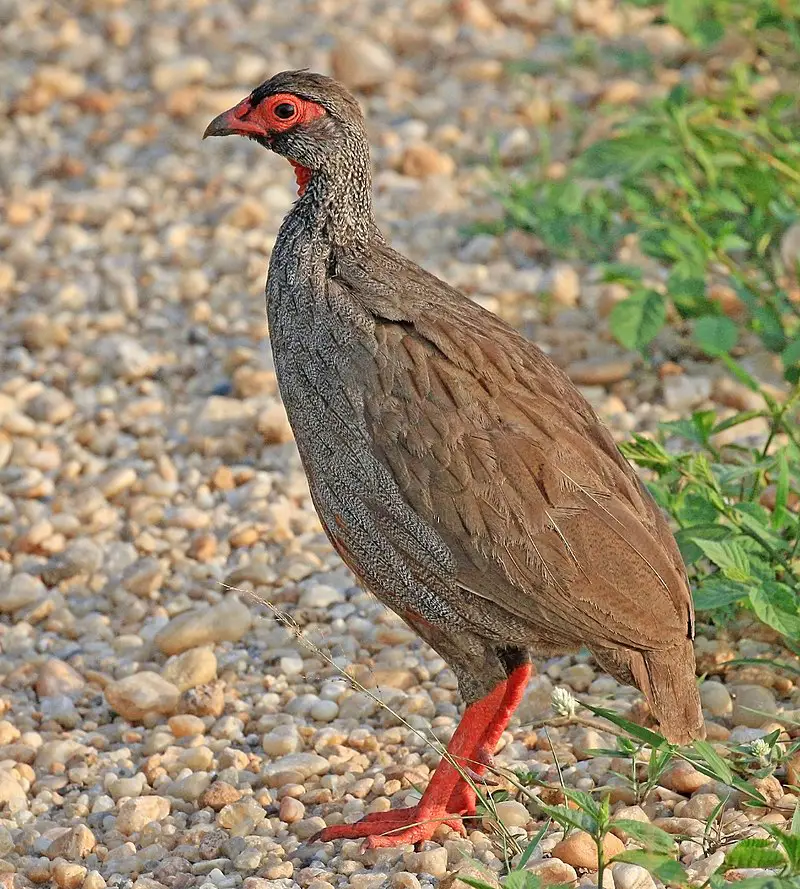
The Red-necked Spurfowl is a gamebird belonging to the pheasant family Phasianidae and is natively found in southern Africa.
It was first described by German zoologist Philipp Ludwig Statius Müller in 1776, with its type locality being Benguela in western Angola.
This bird has been known for having two distinct color morphs – greyish or chestnut brown plumage on their back and wings, as well as dark spots near its eyes that are bordered underneath by white stripes.
They also have bright rednecks, which earned them the name ‘Red-necked’
These birds can be seen scavenging around human settlements during the day, searching for food such as seeds, berries, and insects, amongst other things like small reptiles.
Despite their small size, they can defend themselves against predators due to some individuals possessing spurs at the end of each wing joint that act similarly to talons when attacking an enemy.
Scientific classification:
| Kingdom | Animalia |
| Phylum | Chordata |
| Class | Aves |
| Order | Galliformes |
| Family | Phasianidae |
| Genus | Pternistis |
| Species | P. afer |
42. Scaly Spurfowl
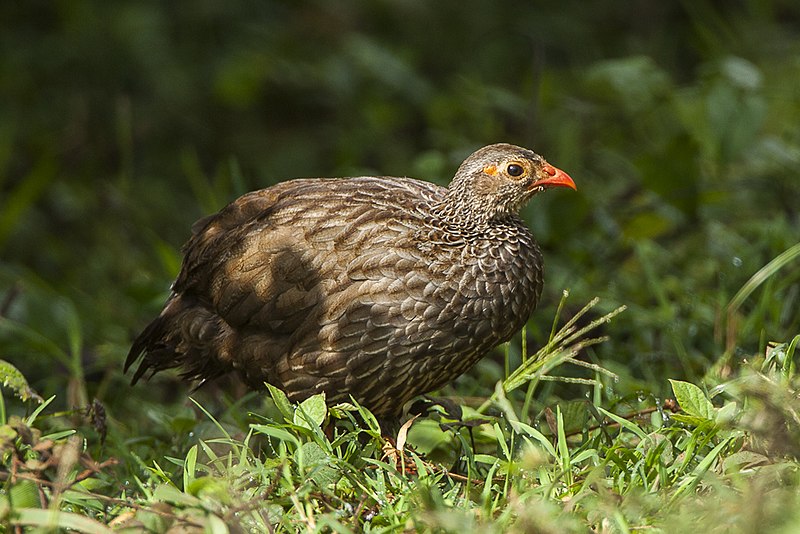
The Scaly Spurfowl is a bird species belonging to the family Phasianidae. It can be found in several African countries such as Angola, Burundi, Cameroon, etc.
This small-sized bird has scaly feathers that are brownish grey on its body with black markings on its wings and tail.
Its legs are short but strong, with spurs at the back of its feet used for defense against predators.
The diet mainly consists of seeds, fruits, insects, and other small animals like lizards or frogs, which they find around their habitat.
They typically live in pairs or groups within well-vegetated areas near water sources, such as riverside forests or grasslands, where there is plenty of food available for them to feed upon.
Scientific classification:
| Kingdom | Animalia |
| Phylum | Chordata |
| Class | Aves |
| Order | Galliformes |
| Family | Phasianidae |
| Genus | Pternistis |
| Species | P. squamatus |
43. Klaas’s Cuckoo
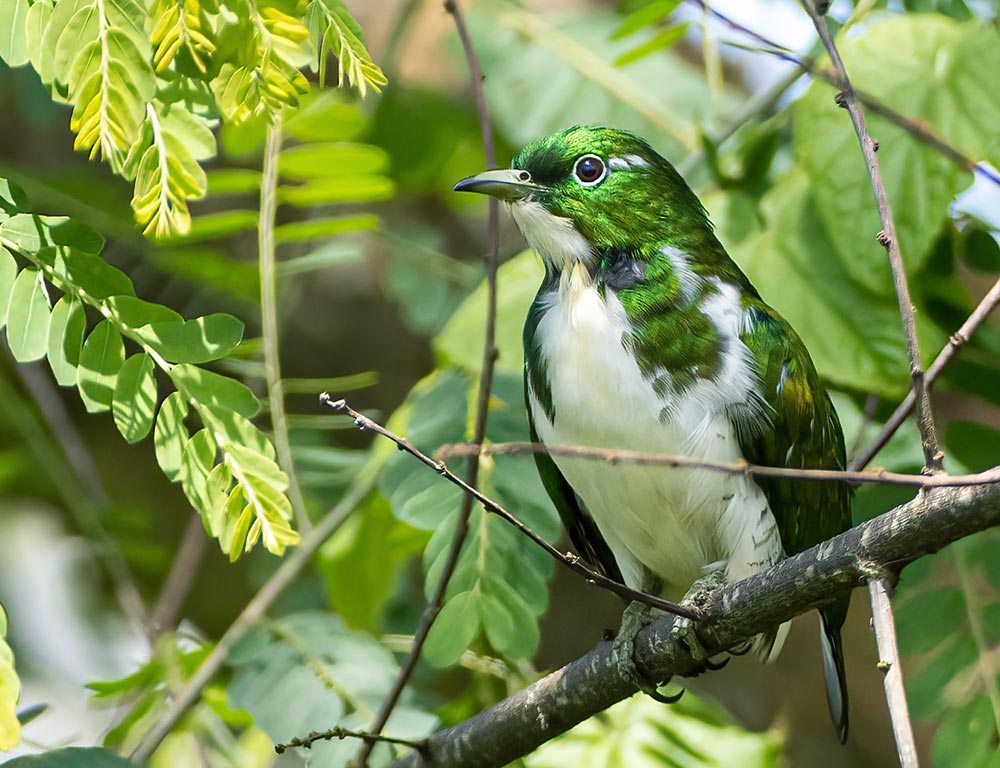
Klaas’s cuckoo is a species of bird found in the wooded areas of sub-Saharan Africa.
The unique species was named after Klaas, the Khoikhoi man who collected the first specimen and presented it to French explorer François Le Vaillant in 1806.
It belongs to the family Cuculidae, which encompasses many cuckoos worldwide, including Old World cuckoos native to Eurasia and New World tropical cuckoos from Central and South America.
This small bird can be identified by its greyish back, white belly with dark streaks on either side, yellowish brown wings with black tips along tail feathers, red eyes, pale bill, and blue legs.
Its diet consists mainly of insects such as caterpillars, while they are also known for their parasitic behavior, where they lay eggs inside other birds’ nests instead of building their own nest or incubating them themselves.
Overall, Klaas’s cuckoo is an interesting yet enigmatic creature that has been studied for centuries but still holds much mystery about itself.
Scientific classification:
| Kingdom | Animalia |
| Phylum | Chordata |
| Class | Aves |
| Order | Cuculiformes |
| Family | Cuculidae |
| Genus | Chrysococcyx |
| Species | C. klaas |
44. Splendid Starling
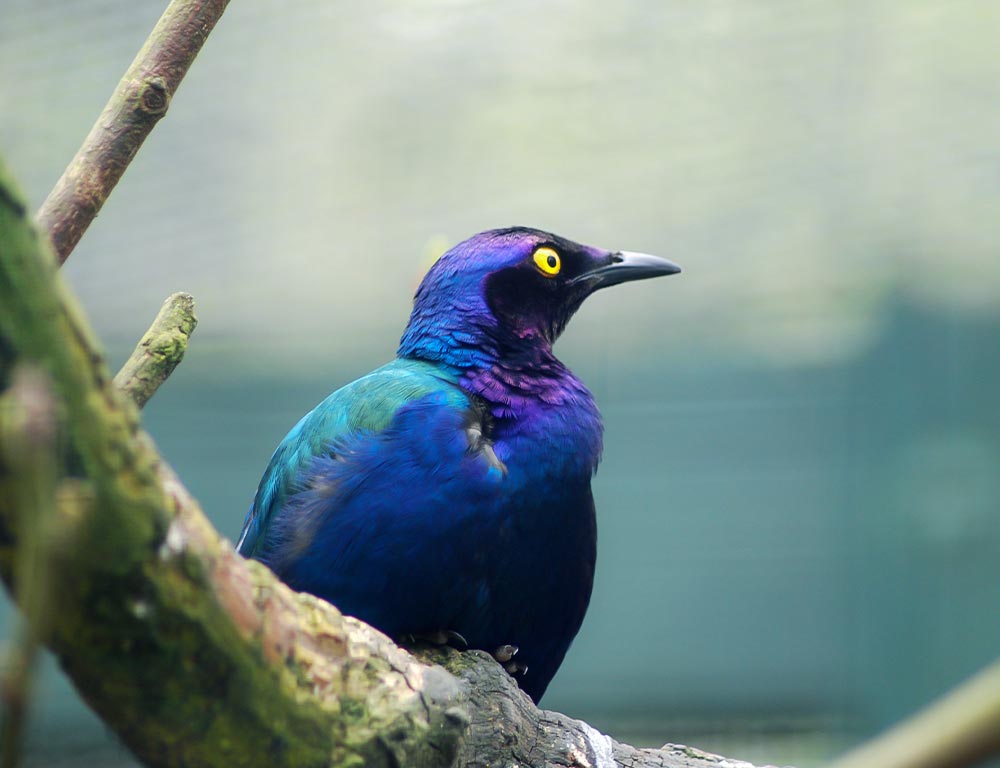
The Splendid Starling, also known as the Splendid Glossy Starling, is a beautiful bird with glossy black feathers and blue iridescent highlights on its wings.
It resides in several African countries such as Angola, Benin, Botswana, Burundi, and many more. Its diet consists mostly of insects but has been known to eat grains and fruits.
The starlings often gather into large flocks, which are loud during flight due to their chattering. They build nests at the top of trees or buildings where they lay eggs that hatch after an 11-13-day incubation period by both parents.
These birds have long been kept as pets because of their stunning appearance; however, they require special care since they can become aggressive if not handled properly or when threatened in any way.
All in all these majestic creatures make for an enjoyable sight whether alone or gathered together.
Scientific classification:
| Kingdom | Animalia |
| Phylum | Chordata |
| Class | Aves |
| Order | Passeriformes |
| Family | Sturnidae |
| Genus | Lamprotornis |
| Species | L. splendidus |
45. Olive Ibis
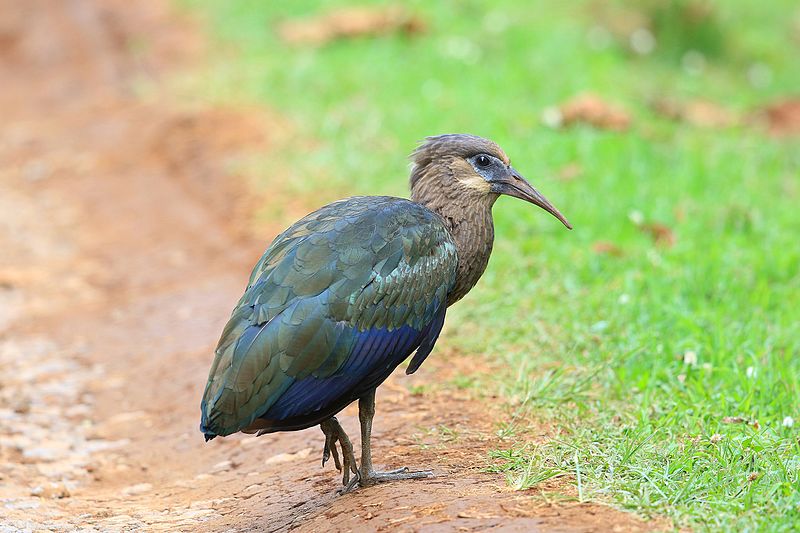
The Olive Ibis is an elegant bird native to dense tropical forests in central Africa. It measures between 65 and 75 cm long and has a beautiful olive plumage with a shimmering iridescence.
This species has four subspecies: Geronticus, Comatibis, Harpiprion, and Bostrychi. The Olive Ibis forages for food on the ground, where it finds insects and small reptiles or mammals that form their diet.
They have also been known to feed on carrion from time to time.
This stunning bird can be seen flying across rivers or open fields but usually prefers wooded areas near water sources like swamps or wetlands since they need high humidity levels for survival.
Scientific classification:
| Kingdom | Animalia |
| Phylum | Chordata |
| Class | Aves |
| Order | Pelecaniformes |
| Family | Threskiornithidae |
| Genus | Bostrychia |
| Species | B. olivacea |
46. Lesser Moorhen
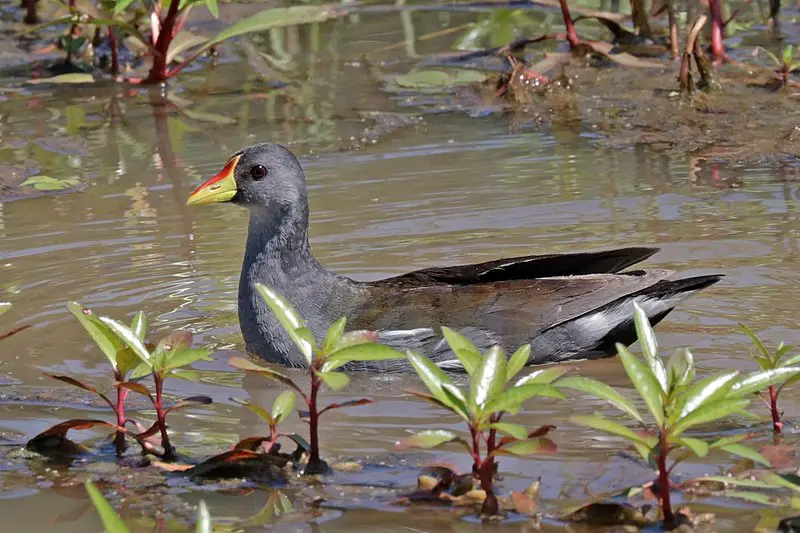
The Lesser Moorhen is a species of bird belonging to the family Rallidae. It is found in Sub-Saharan Africa but not in Southern Africa or Madagascar.
This species was previously placed in the genus Gallinula, however a 2015 study revealed its genetic distinctiveness which led it to be placed into the newly established Paragallinula genus.
It has a dark brown plumage with white underparts and distinctive yellow legs.
Its bill is also yellowish-brown and hooked at the tip for catching prey such as insects, crustaceans, and mollusks from shallow water bodies like marshes, ponds, rivers, etc., where they are commonly seen swimming about.
Scientific classification:
| Kingdom | Animalia |
| Phylum | Chordata |
| Class | Aves |
| Order | Gruiformes |
| Family | Rallidae |
| Genus | Paragallinula Sangster, Garcia-R & Trewick, 2015 |
| Species | P. angulata |
47. White-Winged Widowbird
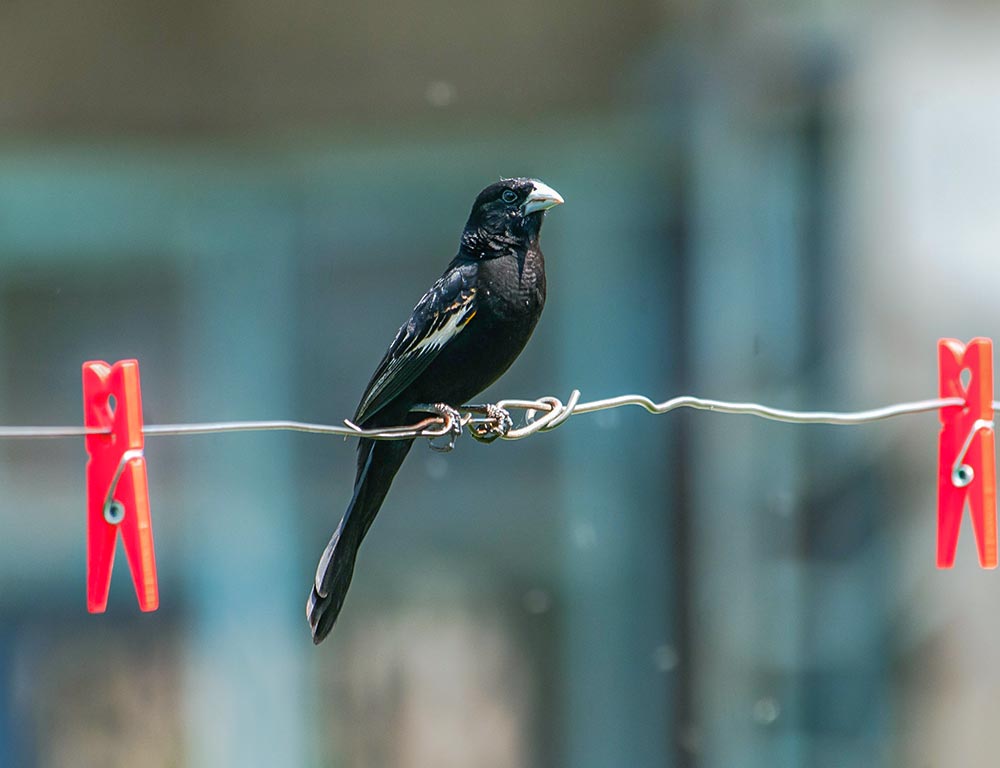
The White-winged Widowbird is a species of passerine bird found in Africa south of the Sahara.
The males have an impressive display during the breeding season, with their yellow plumage turning dark and them gaining white feathers – this contrasts with the female’s mostly pale coloration.
There are three recognized subspecies: bicolor, albonotatus, and magnovenator.
During mating season, these birds perform spectacular courtship dances that involve leaping into the air while fluttering wings and singing complex songs from atop tall perches or telephone wires.
They mainly feed on grass seeds but will also eat insects when available.
Overall, they are considered common throughout much of their range due to their adaptability and resilience to environmental changes brought about by human activities like agriculture intensification or urbanization.
Scientific classification:
| Kingdom | Animalia |
| Phylum | Chordata |
| Class | Aves |
| Order | Passeriformes |
| Family | Ploceidae |
| Genus | Euplectes |
| Species | E. albonotatus |
Also Featured In: Savanna Birds You Need to See,
48. African Pied Wagtail
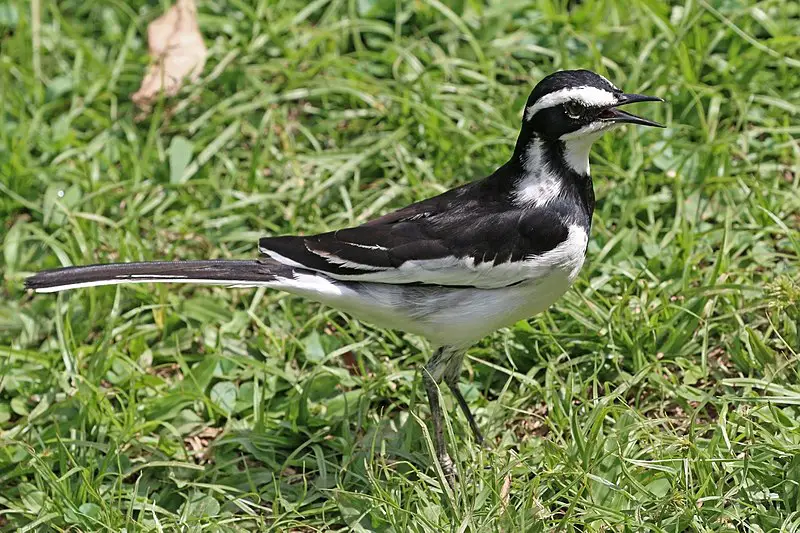
The African pied wagtail is a beautiful bird with striking black and white feathers. At 20 cm in length, it makes an eye-catching sight wherever it goes.
The upper parts of the body are deep black, while its underparts are pure white, with a distinctive white supercilium and wing patch when seen at rest.
Juveniles have greyer colors than adults, while birds from the nominate subspecies show grey flanks.
These stunning wagtails can be found near wetlands or on open grassland during migration season, but they spend most of their time around streams and rivers throughout Africa, where they feed mainly on small insects such as flies, beetles, and spiders that live close to water sources.
They may also eat some berries or seeds if available.
Scientific classification:
| Kingdom | Animalia |
| Phylum | Chordata |
| Class | Aves |
| Order | Passeriformes |
| Family | Motacillidae |
| Genus | Motacilla |
| Species | M. aguimp |
49. Black-Headed Weaver
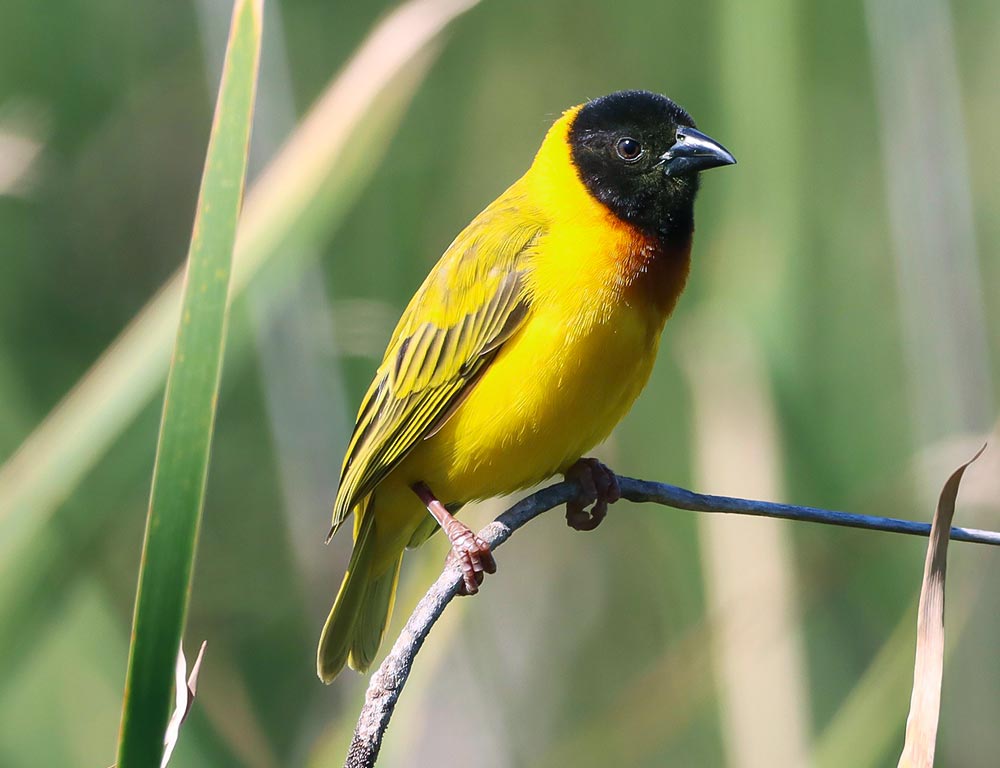
The Black-headed Weaver is a species of bird found in the Ploceidae family. It is mainly identified by its black head and yellow nuchal collar, distinguishing it from similar weaver birds.
During the breeding season, males have these features, while females usually lack them. The Juba and Golden-backed Weavers are very close relatives to this species but can be differentiated due to their physical characteristics and behavior patterns.
P Victoria Ash has been determined to be a hybrid between the Black-headed Weaver and Ploceus casinos, so they should not be confused when observing in nature or captivity.
All three weave intricate nests out of grasses that hang like pendants from trees near open water sources where food is abundant for these active birds who spend most of their time foraging or constructing homes together within large colonies.
Scientific classification:
| Kingdom | Animalia |
| Phylum | Chordata |
| Class | Aves |
| Order | Passeriformes |
| Family | Ploceidae |
| Genus | Ploceus |
| Species | P. melanocephalus |
50. Grey-Rumped Swallow
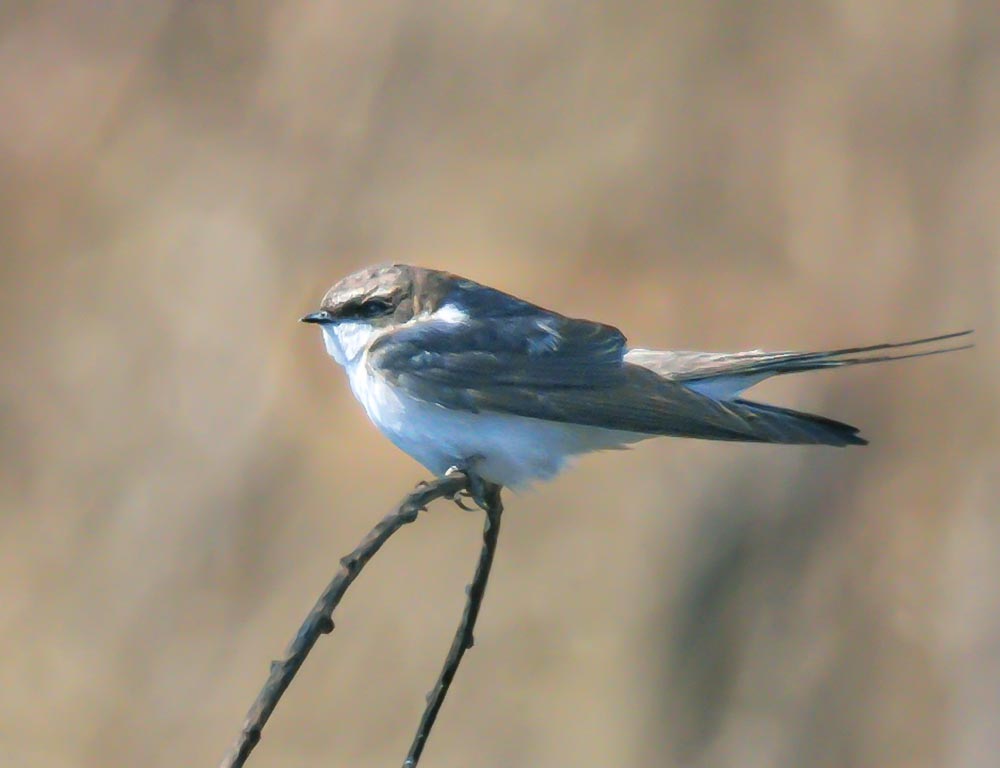
The Grey-rumped Swallow is a stunning species of swallow found in many African countries. This medium-sized bird has grey plumage, a white throat, and an orange rump, which gives the bird its name.
It feeds on insects by flying close to water bodies or over open fields and builds cup nests, often near human settlements such as villages and farms.
Its range includes Angola, Benin, Botswana, Burkina Faso, Burundi, and other African nations from Cameroon to Gambia.
Although primarily insectivorous, this swallow may occasionally eat fruits like figs. The population size of this species is decreasing due mainly to habitat loss caused by deforestation activities that destroy their nesting sites.
Conservation efforts are needed to ensure that these beautiful birds will continue to thrive throughout Africa for generations to come.
Scientific classification:
| Kingdom | Animalia |
| Phylum | Chordata |
| Class | Aves |
| Order | Passeriformes |
| Family | Hirundinidae |
| Genus | Pseudhirundo Roberts, 1922 |
| Species | P. griseopyga |
51. Plain-Backed Pipit
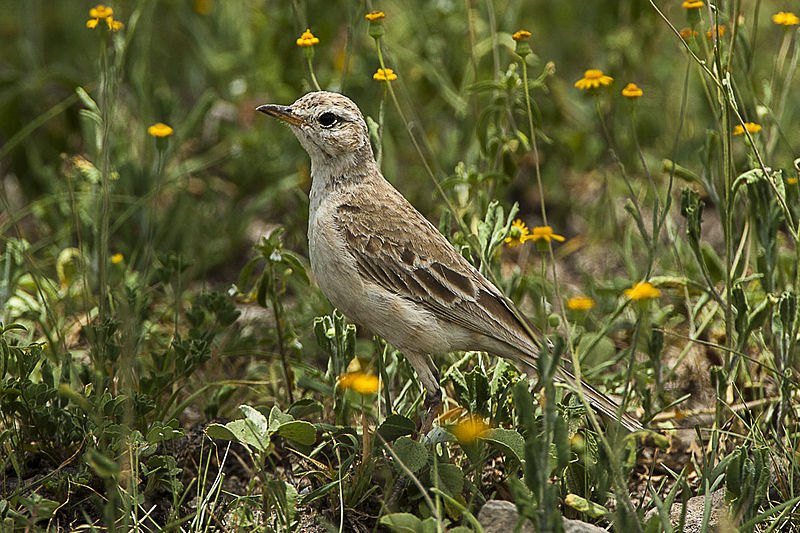
The Plain-backed pipit is a medium-sized passerine bird that can be found in open habitats such as short grassland and cultivation areas. It builds its cup-shaped nest on the ground, usually laying three eggs simultaneously.
These birds are insectivorous, feeding mainly on bugs and small insects. They are also easily identifiable by their larger size than most other species of Pipits, coming in around 17 cm long.
Despite living primarily in Africa south of the Sahara Desert, it has been spotted elsewhere, including parts of India where it winters when not breeding back home.
Though these birds may look plain from afar, up close, you can see why they have become quite popular among birdwatchers for their beautiful brown feathers with white streaks throughout them.
Scientific classification:
| Kingdom | Animalia |
| Phylum | Chordata |
| Class | Aves |
| Order | Passeriformes |
| Family | Motacillidae |
| Genus | Anthus |
| Species | A. leucophrys |
Conclusion
The rich avian diversity of São Tomé and Príncipe, a small island nation in the Gulf of Guinea, is truly remarkable.
With 51 bird species inhabiting these pristine tropical forests, wetlands, and coastal areas, the archipelago offers a unique haven for ornithologists and nature enthusiasts alike.
From the elusive São Tomé olive pigeon to the vibrant São Tomé paradise flycatcher, these avian treasures demonstrate the importance of preserving and conserving the islands’ natural habitats.
As these fragile ecosystems face various threats, including habitat loss and invasive species, it becomes imperative to continue conservation and sustainable tourism efforts to safeguard the future of São Tomé and Príncipe’s magnificent birdlife.